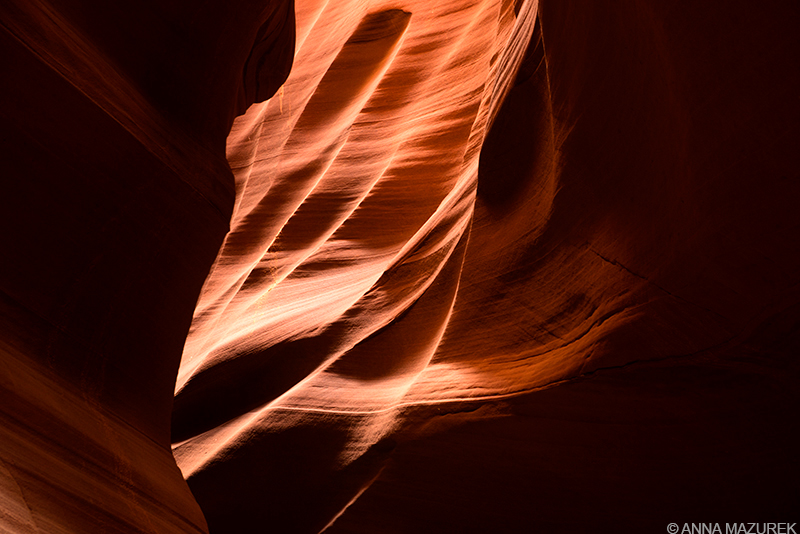
A Photo Guide to Antelope Canyon

Upper Antelope Canyon in Page, Arizona is a photographer’s dream. (Image was shot at f/8 at 1/4 second at ISO 400.)
Arizona won the natural wonder jackpot.
Upper Antelope Canyon is a perfect example – a hidden orange-walled slot canyon with clouds of dust swirling in the light beams. The best part is that it’s only a two-hour drive from the Grand Canyon!
Beauty always has a dark side though. The canyon was formed by erosion from flash floods that flow off the nearby mountains, which still cause a threat to visitors today. The other downside is the crowds – the canyon is literally packed.
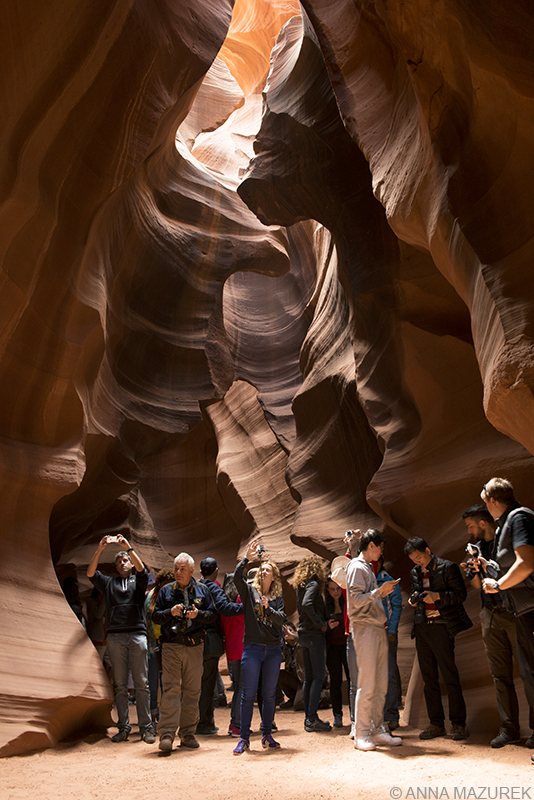
The only way to get photos without the crowds is to book a photo tour. The guides hold back the crowds for short periods of time.
After my last minute detour to Chaco Canyon, the next stop on my Southwest road trip was Page, Arizona for a photo tour of Upper Antelope Canyon, which is located on Navajo land. Overall, I’m really glad I got to visit the canyon despite the crowds – it was absolutely stunning! I only regret not having more time so there will be more trips out here! My biggest tip: Book your tour and photo permit over a month in advance. Check out my detailed guide below for more tips on planning your own trip and getting a photo permit!
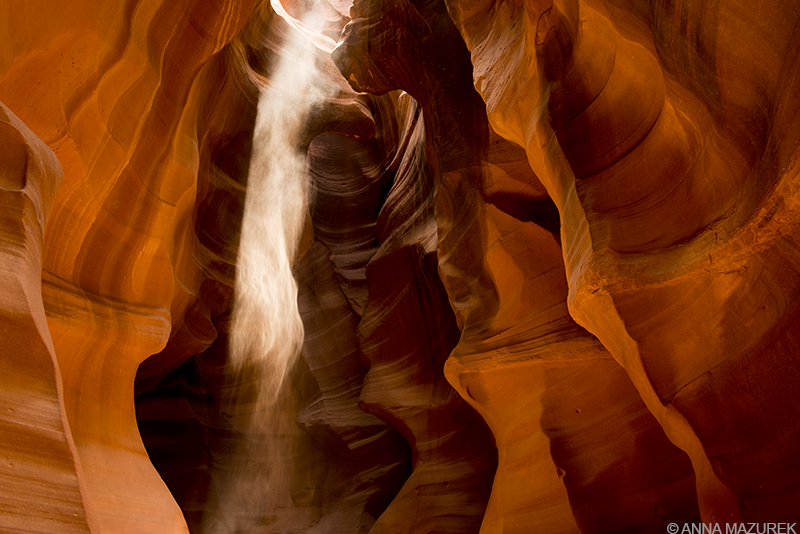
This image of sand floating in the light beams was shot at f/8 at 1/4 of second at ISO 400 on Nikon D800 with a 24-70mm lens.
Everything You Need to Know About Antelope Canyon
When to Visit: Technically, there are two Antelope Canyons. Upper Antelope Canyon is at ground level, and the lesser visited Lower Antelope Canyon involves a series of stairways. Upper Antelope is the most famous due to its signature light beams. There are also three other slot canyons nearby that you can visit: Rattlesnake Canyon, Owl Canyon and Mountain Sheep Canyon.
For Upper Antelope, light beams peak between late March and early October during mid-morning. There are smaller crowds at other times of year.
Photography Tours: The canyon is accessible by tour only. There are five tour companies and prices range from $88 USD for a two-hour photo tour to $48 USD for a regular tour. Only people on the photo tour are allowed to bring tripods into the canyon. The guides do an AMAZING job of keeping people out of your shots. (You get a two or three minutes at a time to take photos while they hold the crowds back.) Tours fill quickly so book in advance. I recommend booking a month out! I used Adventurous Antelope Canyon for my tour.
The one downside to the tour is that the guides spend half the time throwing sand into the light beams. Since I’m not a fan of posed or staged photos, it was really frustrating. Honestly, I would have rather had photos without the sand.
Navajo Nation Photography Permits: Antelope Canyon is located on the Navajo Indian Reservation. A $50 photo permit is required if you are going to use your images for “commercial” use, which basically means if you make money off the photos then you need a permit. I was told that even if I wanted to post the photos on Instagram I needed a permit. My tour company was adamant that I have the permit with me during the tour, but no one checked. Fees are significantly higher if you attempt to get a permit after your visit.
The process to get a photography permit is very third-world. My tour company gave me a website link that didn’t work and a series of phone numbers to call. No answer. Finally, I got a person who gave me another series of numbers and the process repeated. Once I finally found the correct office, I spoke with Shana, who was extremely nice and helpful. Ask for her if you call!
The turnaround time for most Navajo Nation Photography Permits is 30 days. The cost is $50 per site, which can only be paid by check or money order. You must know the date and time of your tour/visit when you apply.
There are six locations that require a photography permit:
- Camp Assayi/Bowl Canyon
- Canyon de Chelly
- Four Corners Monument
- Lake Powell Navajo Tribal Park (Antelope Canyon)
- Little Colorado River Tribal Park
- Monument Valley Navajo Tribal Park
For questions, call the numbers listed on the application form that corresponds to your destination.
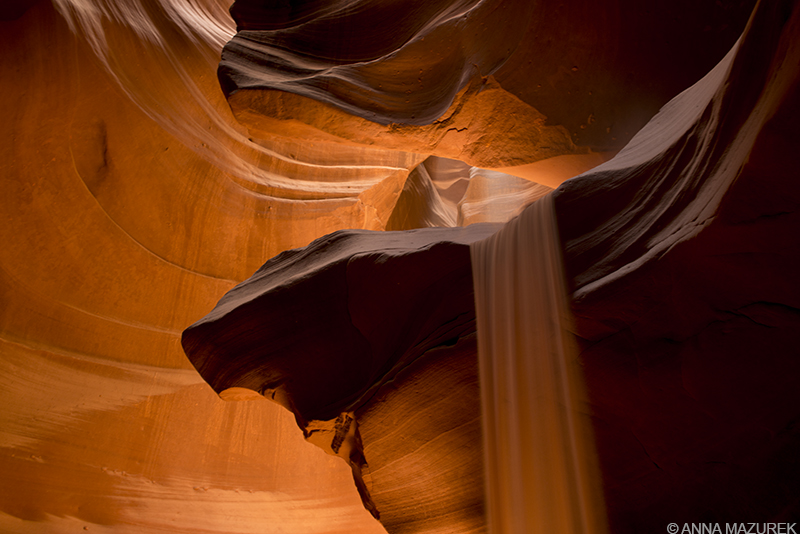
Slower shutter speeds help achieve motion blur with the movement of the sand. This image was shot at .4 of a second at ISO 800.
Tips for Photographing Antelope Canyon
- Take a sturdy tripod. There were way too many people with flimsy tripods. The canyon is tight, and people will be bumping into your tripod so bring one that will support your camera’s weight.
- Use a Wide Angle Lens. You will want to shoot wide in the canyon to capture everything. Do NOT change lenses in the canyon – there’s too much dust! Your aperture should be anywhere from f/8 to f/18.
- Use a remote to avoid motion blur. A remote will help prevent camera movement and keep your images sharp! Recommended shutter speeds range from two to 20 seconds. On average, my shutter speed ranged from 1/4 to 1/25 of a second. You only have a minute or two to shoot once they hold the crowds back so make the most of it!
- Low ISO. To avoid grainy images, consider shooting at ISO 200-400. I rarely went above 400.
- Cloudy White Balance. Cloudy and shade white balance options both add a bit of red to the image, which accentuates the rock’s natural color.
- Take a lens cloth. Due to all the dust in the air, keep an eye on your lens and clean it regularly.
********************************************
COMING UP:
TRAVEL TUESDAY INTERVIEW: Couchsurfing Around the World
In the next Travel Tuesday Interview, I talk with longtime Couchsurfer Nishant Prasad about his experience saving money on accommodation during his travels by sleeping on couches. (He even met his fiancé through Couchsurfing!)
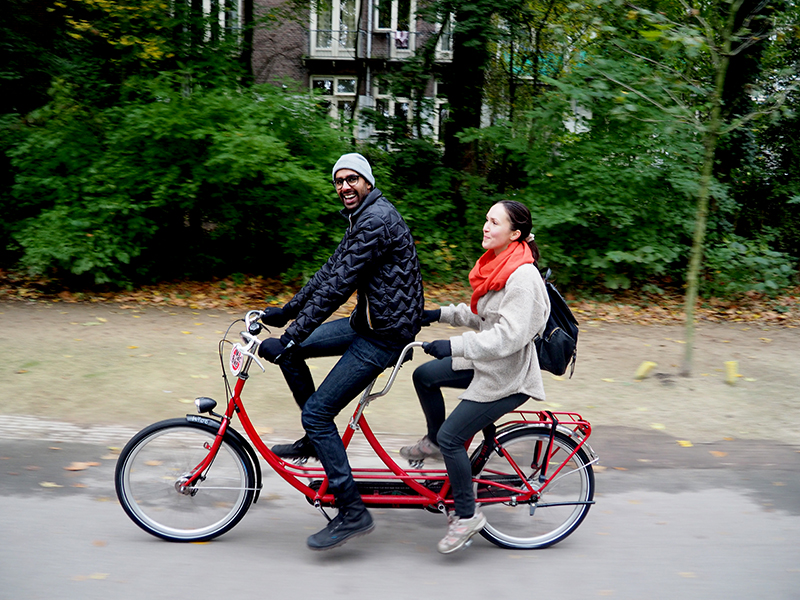
Nishant Prasand and his finance Isabelle biking around Amsterdam.
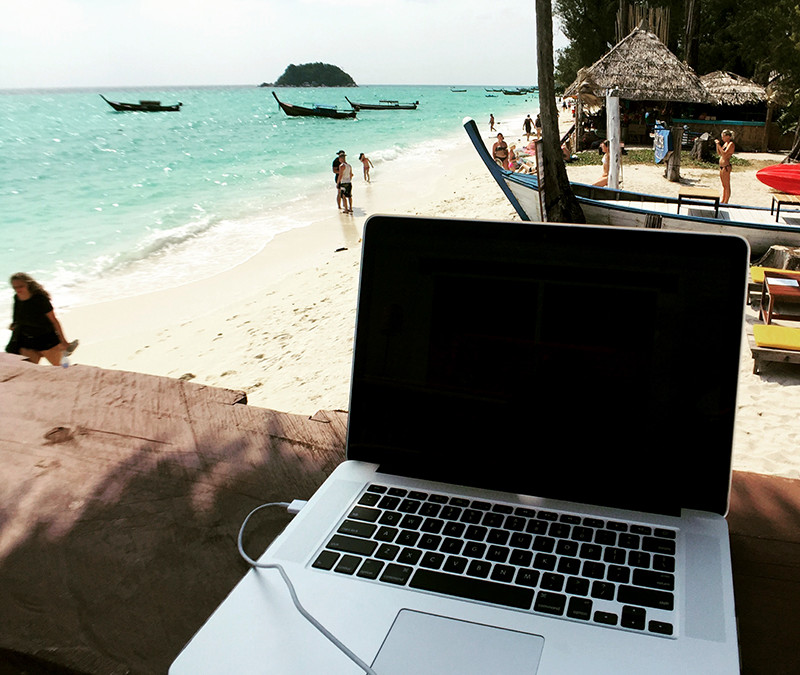
Life as a Location-Independent Entrepreneur

Michael Lythcott has been working from remote corners of the world since he started his web design firm in 2005. I met Michael at one of his bon voyage parties in NYC in 2014. After following his adventures on Facebook, I reached out to ask him about the pros and cons of running a business from the road.
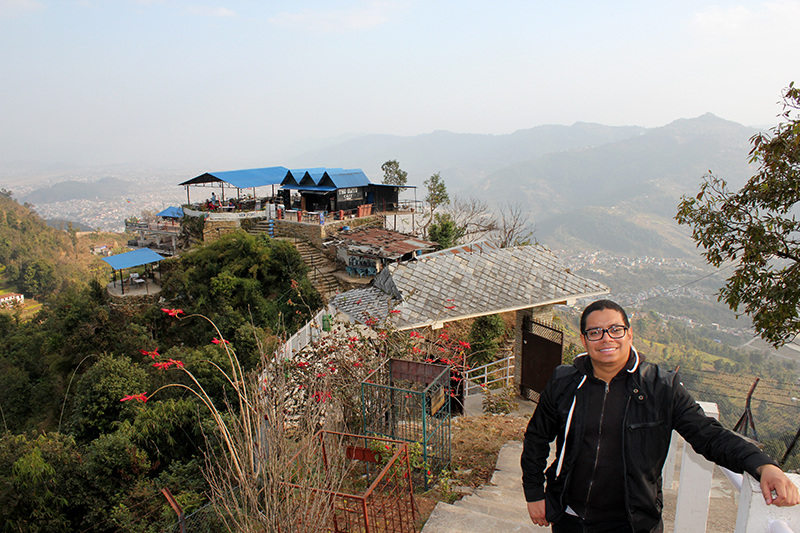
Traveling entrepreneur Michael Lythcott spent some time traveling in Pokhara, Nepal in 2014. (Photos courtesy of Michael Lythcott)
Name: Michael Lythcott
Age: 36
Hometown: Brooklyn, NY
Country Count: 35
Blog/Website: www.wheresmikey.com
1. How did you start traveling?
When I was 16, I started following bands around the U.S. and realized I really liked going to new places and meeting new people. I used to photograph tons of bands so I was always at a festival or concert, and I met so many amazing people. I learned how to travel cheap, too. Hopping along with bands in their van (in return for photos), joining car pools to music festivals, etc. And, when I was 21, I had just started riding a motorcycle. Motorcycles get great gas mileage, so I decided in the summer of 2001 to drive my bike from Atlanta (where I was living) to Vancouver and back. I kind of became obsessed with seeing new places and [increasing the number of] states I had visited.
2. Tell us about your business. How do you manage to work remotely?
I’m a web designer. Me and a buddy started the business back in 2004. In 2005, I left my day job to do the business exclusively. I do front-end visual design for websites, applications and mobile apps. It’s not terribly exciting, but allows me to work remotely, which I do when I travel. Otherwise, I either work at our office in NYC. I was living in Brooklyn for the last eight years, and now, I currently live nowhere! Though the last place [I lived] was Lisbon, Portugal. I work out of a co-work space wherever I am.
3. Do you have an office?
To follow up the previous question, our company consists of a few people, and we officially have our office in Manhattan. We rent a space from a great start up, www.frame.io. While living in Lisbon, or wherever I will be next, I work out of co-work spaces. Most recently: www.liberdade229.co
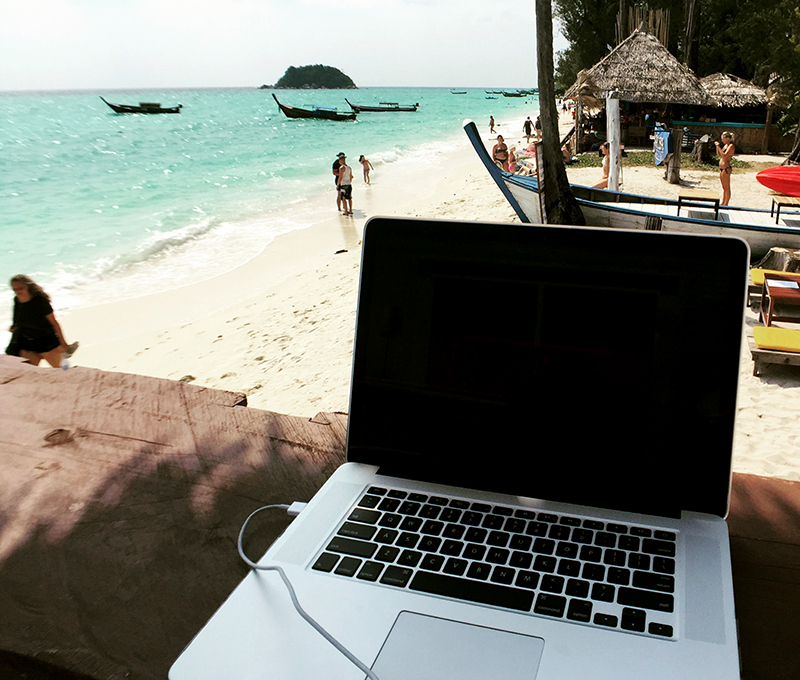
Sometimes, the beaches of Southern Thailand double as Michael Lythcott’s office for his web design firm.
4. What does your average workday look like?
Honestly, when I am actually living in NYC or Lisbon, it’s not too different than anyone else’s. I get up, go to the office, work and go home. When I travel, my office is usually a hotel lobby (currently, this lobby in Siem Reap, Cambodia, which I am sharing with mosquitos), a beach, hotel room, friend’s couch, or wherever I can get Wi-Fi. And, usually I am working odd hours as I do have to maintain NYC hours.
5. How has working remotely impacted your business? What is the biggest challenge?
We’re a small firm, and we do not have the staff we had before so it’s more like the business impacts me. If we have a lot of projects, I have to cancel or postpone any major trips. When we had a bigger staff, I could leave for three months and still work while traveling knowing that we had other people to leverage the tasks. Now, it mostly falls on me, and when we take on a large project, I have to follow it through and working 12 hours or more ahead of my East Coast co-workers means missing out on a lot of activities in whatever country I am in and having a horrible sleep pattern as a result.
Even when it seems easy to just jump on Google Hangout, working on a different schedule as your team members and not being there in person to bounce off ideas or check work immediately is a problem that is getting harder to solve.
6. Why did you decide to work remotely?
I didn’t decide to work remotely at all. I’ve worked for myself since 2005 so I’ve always had the ability to travel and work from anywhere. As my passion grew to traveling internationally, it was just no different than working from home, except I was doing it from far away.
“I was able to travel without having to worry about not getting my work done, so working remotely was just a natural extension of what I was already doing. Except I was doing it from Paris or Istanbul!”
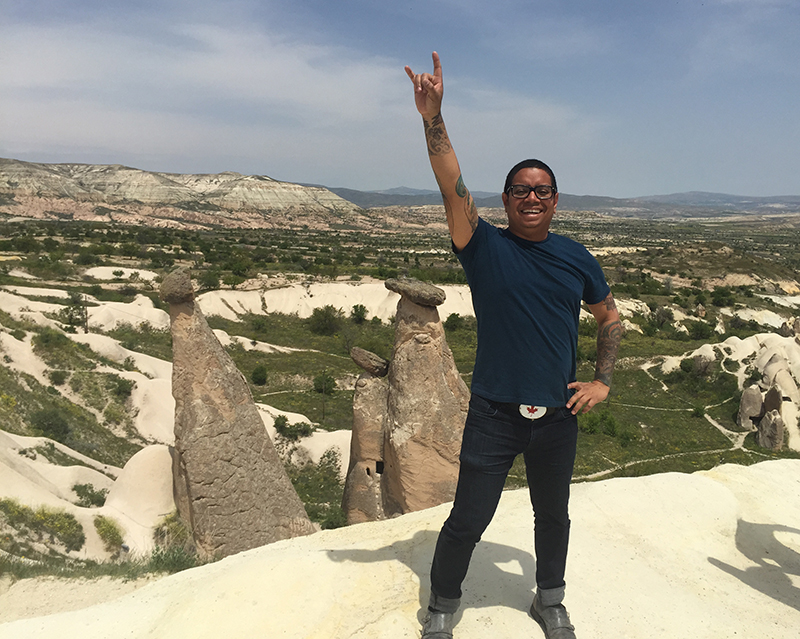
Turkey is one of Michael’s favorite places to work/travel. He fit Cappadocia in his schedule last year to visit the famous rock formations.
7. Share one of your travel highlights.
Turkey is a place of magic and history that has yet to fade. Every time I go, I have a blast in Istanbul (five times now). It’s so big that every visit I end up at a new place I have yet to see. I find a new favorite local restaurant, bar, tourist destination, historical landmark, or nightlife spot every time I go. And, a few buddies of mine there own some late night hotspots and hotels, so it’s never a dull moment at night. And, exploring the country never lets me down either. Every separate trip offers something new. One trip we did the south from Bodrum (amazing castles) to Marmaris and a southern cruise on a gulet (wooden sailboat). I’ve seen the ancient Roman ruins of Ephesus. I went to Cappadocia for my first time last May, and the sheer beauty was unique in its own right.
I guess I could continue to list off all of my top destinations, but the thing about all of my travels is that it’s about the people more than the places. Yes, I love all the “bucket list” destinations and bragging, but none of it would mean a thing to me if it weren’t for the people.
8. What advice would you have for aspiring travelers who want to balance work and travel?
Be as self sufficient as possible and know your craft as best as possible so you can do everything yourself and not have to rely on others. As mentioned earlier, the hardest part of working remotely is having to rely on other people, who will have a different schedule as you. To find balance, you have to be strong in your skills and be disciplined enough to accept that your schedule will be inconvenient at best. If you have multiple co-workers, see if you can spread out the work in a way that allows you to travel while meeting deadlines without upsetting anyone.
I’ve missed out on some great events while traveling because I had to work suddenly. But a lot of those times, I was on the beach, or at the very least, in a foreign place with a plate of unique food next to me. So, I take comfort in that. It is hard, but simply being in the moment in a new place is enough of a balance for me.
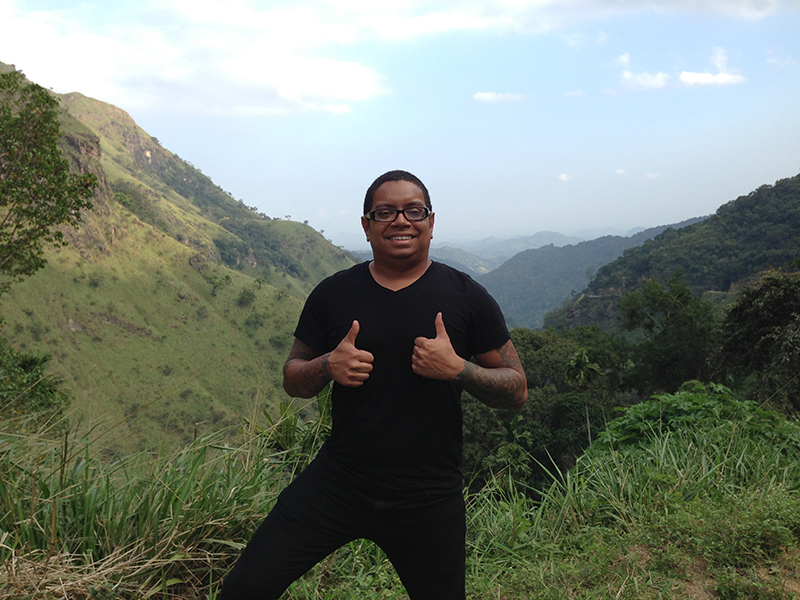
When Michael Lythcott is not working out of a co-working space in Lisbon or NYC, he’s exploring places like Sri Lanka above.
9. Name three things you always pack for a trip.
Firstly, I have my iPhone wide angle lens. I can hang it off my keychain, but it allows me to take amazing shots without always having to have my camera.
Secondly, I always carry an electronics kit with a few basic items: one of each type of world plug (Asia, UK, and Australia), my mini power strip that has three U.S. outlets and two USB charging points, so when I plug in via a converter, I can charge my phone and camera at once, my laptop and have two spots left for friends to also plug in their devices.
Thirdly, a nice outfit. Usually, my Zara black button-up, a black tie and at least, one pair of nice jeans that can also double as “fancy” pants. This way, I can always be ready for a nice night out, even if I am on a beach in Thailand somewhere. I pack light so I actually usually have space for all three of these things AND my clothes and other basics.
10. What is your next adventure?
Well, starting soon, I am finally going to expand my travels to South America. Firstly, I want to go to Colombia, Brazil, Guyana (where I was born), Argentina, Chile, Peru, and Ecuador. My next MAJOR trip will happen later this year or early next year. In between though, I will do some short trips to Eastern Europe to hit up some friends and some places I haven’t been (Poland, Lithuania, Hungary, Slovakia, Croatia).
********************************************
COMING UP:
Tips for Visiting & Photographing Antelope Canyon
Antelope Canyon was one the major stops on my cross-country road trip after Chaco Canyon. In my next post, I’ll cover tips for getting Navajo Nation photo permits and photographing the canyon!

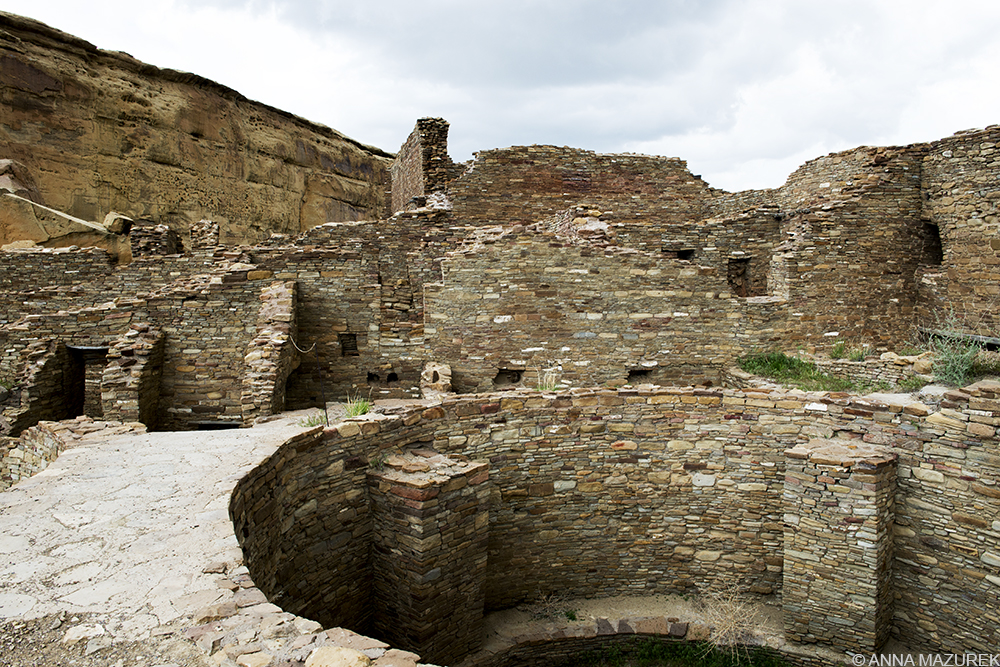
Road Trip Guide to Chaco Canyon

Pueblo Bonito is a stunning set of ancient ruins located at the remote Chaco Culture National Historical Park in New Mexico.
The pavement turned into gravel. My fingers tightened on the steering wheel as the gravel faded into a washboard dirt road. The horizon was empty except for the occasional abandoned house.
My first thought: Am I driving into the beginning of a horror movie?
Earlier that morning, I was at my friend Sean’s apartment in Santa Fe, New Mexico planning my route to Page, Arizona. I was one day into a three-week cross-country road trip. Sean suggested a few places to stop on the way including Chaco Canyon, a national park known for pueblo ruins from the 9th century. Since there’s nothing I love to photograph more than ruins (except for ruins with alpacas!), I jumped at the chance. It was only a 21- mile detour off the main road.
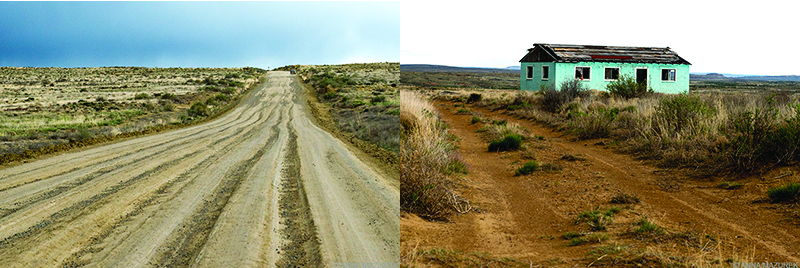
Left: The northern entrance to the park is on Highway 7950 is a rough dirt road. Right: Abandoned houses line the road.
Now, I was regretting that decision as I bounced along the dirt road feeling like I was the backseat of a jeep in rural India. Every two minutes, I considered turning around. I was driving 10 mph, and my car was shaking so violently that I thought it might fall apart at any second.
A black dot appeared on the horizon like a desert mirage and bounced closer into view. It was a black Ford Mustang struggling to get down the road. If a Mustang could drive this road, then so could Betty! (Betty is my Kia Spectra and faithful travel companion.) Then, a small RV appeared on the horizon strategically maneuvering all the ruts in the road. I was clearly in the right place!
The park entrance FINALLY came into view. It was a beautifully PAVED road! I literally screamed “Hallelujah!” out loud. The park itself included a nine-mile paved loop linking the main ruins and several hiking trails to other sites.
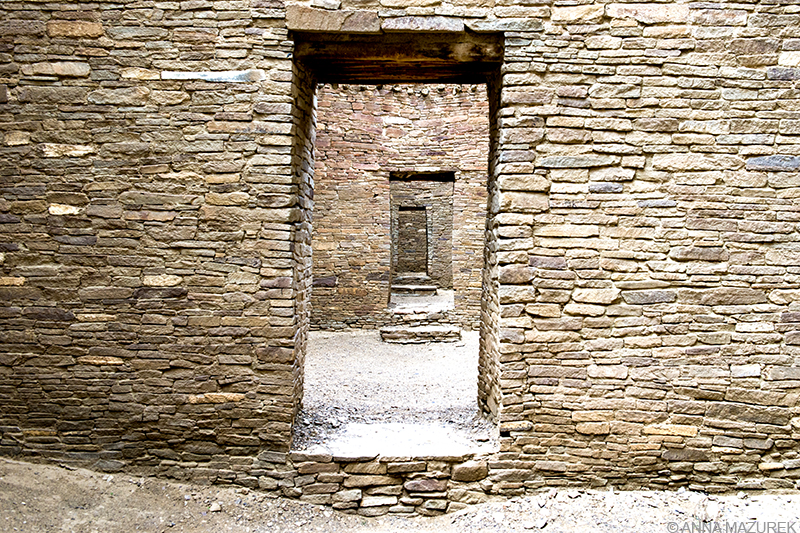
Doorways inside the Pueblo Bonito. Many of the buildings and walls were built for astrological purposes and align with solstices.
My first stop was the most important and stunning set of ruins in the park – Pueblo Bonito. The structure once had four floors and over 660 rooms. The view was surreal and worth every minute of the terrible drive. I instantly felt like I was back at Machu Picchu walking through elaborately built Inca ruins. Both the Chacoans and the Incas were master builders.
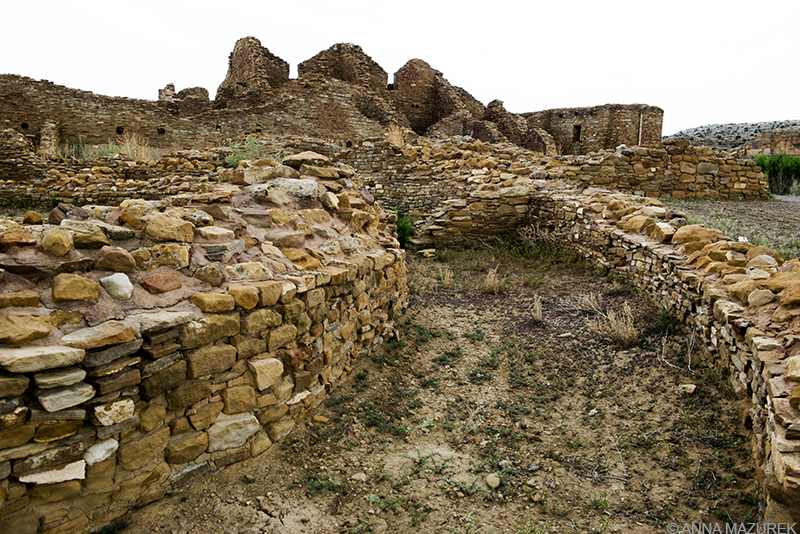
The smaller Pueblo del Arroyo structure was built in two stages between AD 1025 to AD 1125.
A storm started moving in as I was heading to the next set of ruins, Pueblo del Arroyo. The lightning and thunder were intense, but it did not seem to be moving in my direction. I put on my raincoat and used my rain cover for my bag to cover my camera.
My last stop was Casa Rinconada, the largest excavated kiva in the park. (Kivas are partially underground structures used by Puebloans for religious ceremonies.) It was impressive but nothing is as stunning as Pueblo Bonito.
The thunder and lightning appeared to heading off to the North, which was a relief for my photos. It was nearing the deadline I had set to leave the park (3:30 p.m.) in order to make it to my campground reservation in Page, Arizona before they closed at 9 p.m. (It’s a five-hour drive, but the time zone change gave me an extra hour.)
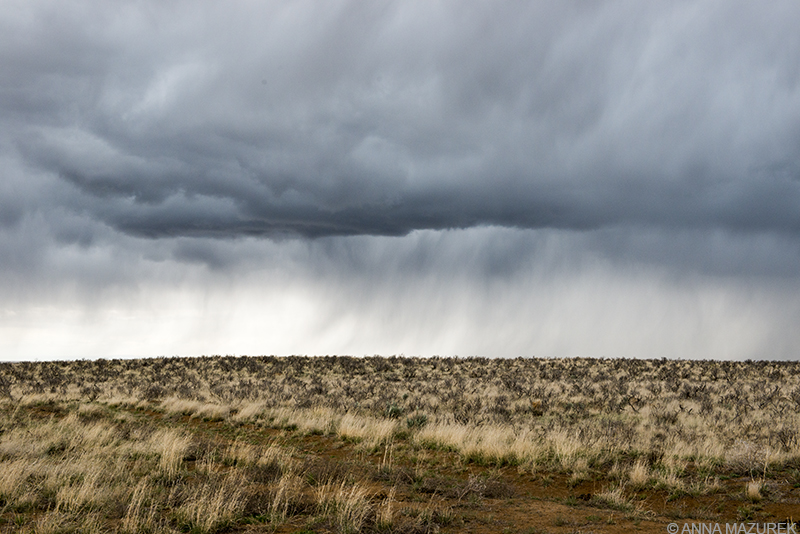
Keep an eye on the weather during any visit to Chaco Canyon. Both entrance roads are dirt and can become very rough.
Then, I realized the storm was headed straight for the nightmarish dirt road, the only northern exit from the park. (There are only two exits, and apparently, that horrible road I took is the best.) I suddenly remembered the dry riverbed I drove across on the way to the park, and the giant signs that read “Do not cross if ANY water is present.” I panicked and headed for the exit.
Once the pavement ended, I was bouncing along through the horror movie set again on the dirt road behind another car. More cars appeared in my rearview mirror trying to beat the storm. I smiled. We were in this adventure together.
The storm loomed in the distance and paralleled the dirt road the entire drive back to the main (nicely paved) highway like a vulture stalking its prey. When I reached the riverbed, it was dry. Even the paved roads were still a bit rough, but I made it to Page, Arizona with 20 minutes to spare.
When I posted a Chaco Canyon photo on Instagram, I laughed at a friend’s comment: “We wanted to go there but ran out of time and worried about getting through the dirt roads!”
Sometimes, the most amazing places are the hardest to reach.
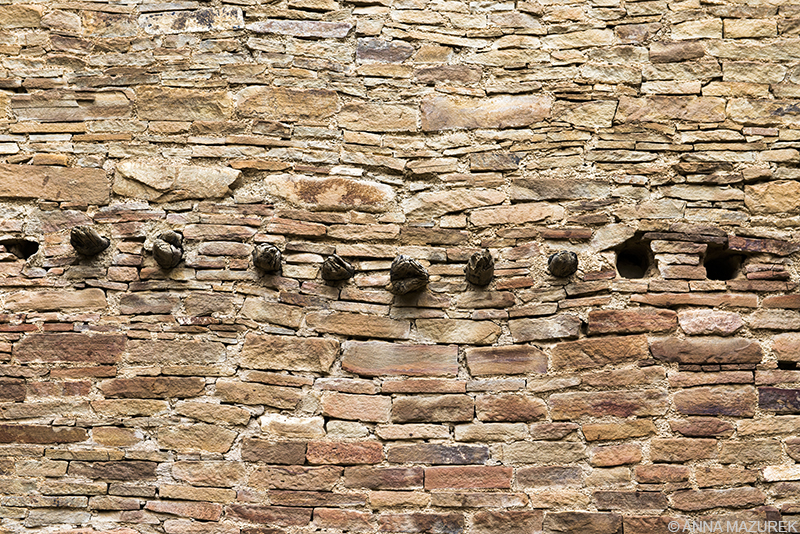
The wooden beams used in the houses came from the Zuni Mountains (50 miles south) and Chuska Mountains (50 miles west).
Tips for Visiting Chaco Canyon
Fees/Camping: $16 per vehicle for 7-day pass; camping is $15 per site and must be reserved in advance.
How to get there: There are two roads to Chaco Culture National Historical Park. (See map here.) From the north coming from I-25: Follow highway 550 past Cuba then turn left just past a convenience store (mile 112.5) onto CR7900. There’s a sign but it’s small. This road ends shortly at a stop sign. Turn right on, CR7950, which deteriorates quickly to a gravel road and eventually leads you to the park, which has glorious paved roads! It’s 20.5 miles from the turn off to the park but it’ll take you a good hour possibly depending on road conditions. From the south of the park: From I-40, take highway 371from Thoreau to highway 9 before turning on CR57. (Highway 371 will take you to Bisti Wilderness as well. You can also get off I-40 at Milan then take highway 605 to 509 to 9.
The road to the north of the park is shorter and more frequently traveled. Both roads can be a mess after rain. Check the weather, and call the visitors center (505-786-7014) for route recommendations before your trip. Cell signal is minimal – do NOT rely on GPS!
Best time to visit: Avoid the winter due to snow and ice. Roads can be messy in the rainy season (July – Sept.). The weather is best in the spring and fall (Sept. – Oct.).
Why are the roads to Chaco Canyon so bad?
According to the visitor’s center, the roads crisscross both county and tribal land. Each party is responsible for the maintenance of their section. There is also industrial traffic from oil fields in the area. Google theorizes that the poor road conditions keep out large-volume tour bus traffic and helps preserve the park, which only has minimal facilities. Learn from my misadventures: If you’re traveling in the Southwestern U.S., be sure to research all road conditions! Some of the roads in the area (including the CR7500 near Bisti Wilderness area) are improving due to the oil companies working in the area.
For more location guides, sign up for my email list below!
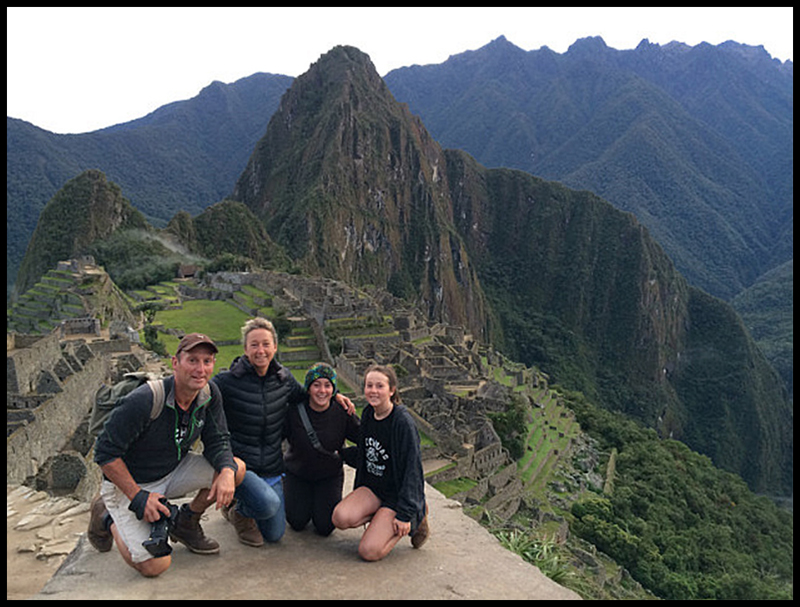
How a Family Spent a Year Traveling

The McGuinness family did the five-day Salkantay trek to Machu Picchu. (All photographs courtesy of the McGuinness family.)

In Sucre, Bolivia, I bumped into the McGuinness family at breakfast at our hostel. I was instantly inspired by their story – a family of four traveling together for a year! Cath shares all the details of their trip including finances, their teenage daughters’ school schedule and great advice for all travelers!
Name: The McGuinness Family: Rob (age 52), Cath (age 50), Beth (age 16), and Megs (age 14)
(Cath is a General Practitioner, and Rob is an Urban Designer.)
Hometown: Truro, Cornwall SW England
Blog: https://www.travelpod.com/travel-blog/mcgrtwtrip/1/tpod.html
1. How far in advance did you start planning your year abroad?
Four years ago, Rob and I had a conversation in the truck on the way home [to England] from a great camping holiday in France saying, “Wouldn’t it be wonderful if we could travel for a year?” We realized there was one specific year when it worked with the girls’ school – September 2014.
We just needed money. Over the next few months, I kept my eyes open for a house. We found a tiny, basic two-bedroom cottage, which we liked a lot and had potential. Big decision to buy it and sell our main house, but we eventually took the plunge and bought. It took two years to sell our main house, which was a disaster. It was a huge financial struggle, renting out the cottage, both having to work 60-70 hours per week, but eventually, we bought our rucksacks and boots, booked our tickets in early September 2014 and were going!
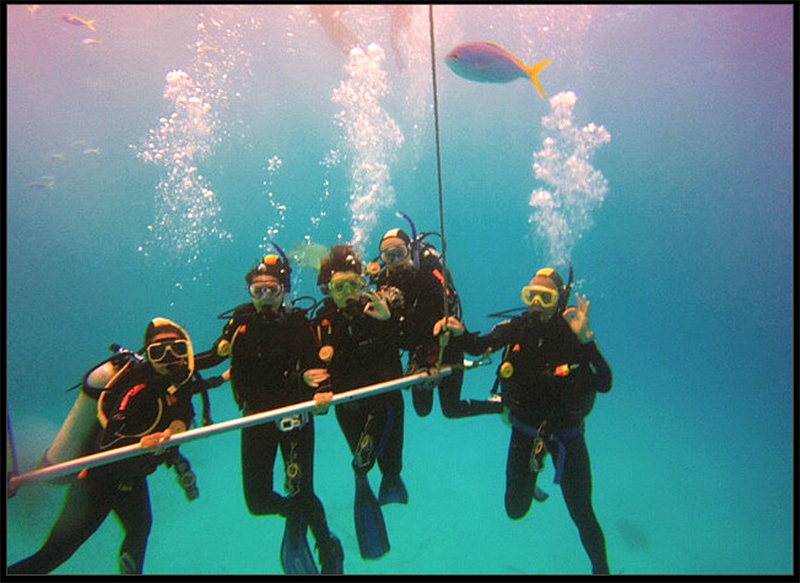
The McGuinness Family at the Great Barrier Reef in Australia (All photographs courtesy of the McGuinness family.)
2. What was your route on the trip?
Our flights took us through Greece (island hopping to get into the backpacking routine), then to India (mainly Rajasthan), on to Nepal and the Annapurna circuit, Hong Kong for a few days, and then, Australia in a camper van down the East Coast to Melbourne. We went onward to New Zealand, then flew across to Chile, Bolivia and Peru, before flying up to the California coast, and the final five days in the Big Apple – New York – before arriving home in June 2015. Our trip was cut short due to issues with my work, but in the end, that turned out to be a good thing. We were traveled out after ten months, I think. It felt right to be going home.
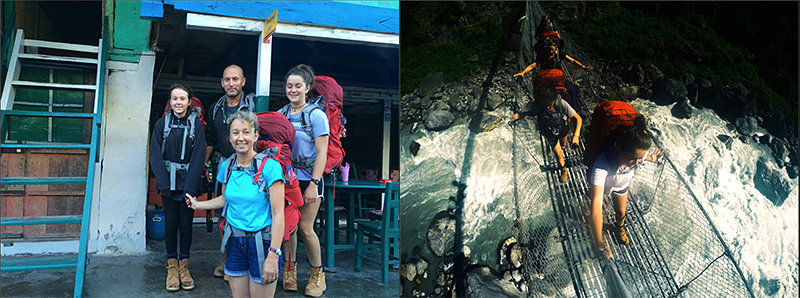
Left: Starting out on the Annapurna trek in Nepal; Right: A wild river crossing on the trek.
3. Share one of your travel highlights.
There were highlights and low lights – highlights were to me, the camel trek overnight in the desert in Rajasthan – wonderful. I’ll never forget the laughs we had on those camels, the wonderful guides and herders – so helpful and kind; watching them cook from nothing, producing the most amazing meal as the night fell over the sand and sleeping under the stars. Some of the treks in New Zealand were really beautiful, and as a family, we worked really well together when there was something active going on. Learning to dive on the Great Barrier Reef. The Salkantay trek in Peru to Machu Picchu was also a real highlight. Favorite cities were New York, Sydney and San Francisco. Don’t miss staying in Undarra near Cairns and visiting the lava tubes if you’re close!
Lows were hitting the blizzard on the Annapurna circuit, which killed some 200 people – we were half way up when it hit and had to turn around from our trek. It really was an education to see and hear the stories of fellow trekkers that had been caught right in the storm and sad to see the terrible losses of foreigners and Nepalese.
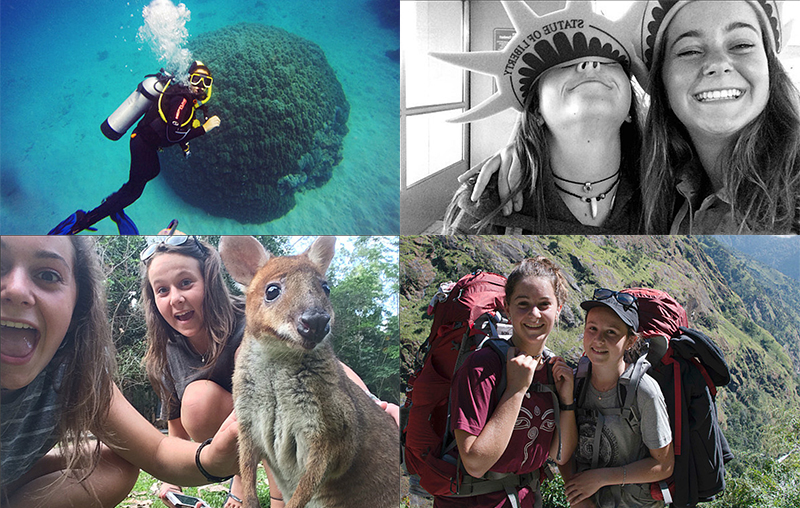
With the help of friends back home, Cath and Rob made sure their daughters Beth, age 16, and Megs, age 14, did not fall behind in their education while traveling. They planned the trip according to their daughters’ school schedules.
4. How did you manage your daughters’ education/school schedule during the trip?
Education was easy in some ways – I did the sciences, math and French. Rob did geography and history, and a friend of ours, who teaches English, helped us with that online. We had little help from [Megs’] old school regarding the curriculum. She certainly wasn’t behind when we got back.
For Beth, we worked through some of her math, she did geography with Rob and French by herself (unsuccessfully). The difficult bit about home education whilst travelling was that you’re moving around all the time so there is no routine, and Wi-Fi is very, and, I mean, very variable.
The main part of our work was done in Australia and New Zealand when we had a car or camper. The moving around was easier, and we could organize lesson times more easily and still see what we wanted. We had to be really strict about it at times, and there were arguments, but overall, it went well considering the circumstances.
It was hard sometimes for them to see the relevance of some subjects but on the other hand – why just read about glaciers, volcanoes and lava tubes if you can walk up them? See the effects of earthquakes in Christchurch? Learn about our part in the history of Sydney, the silver mines in Bolivia and its’ relationship to the American dollar, and checking out buildings built by the Incas in Peru? And, also learning about people around the world, different cultures and different languages. Our girls saw poverty, struggle and disease. People coping with those lives and living good lives. At the same time, they were on Snapchat when there was Wi-Fi and seeing their friends at parties back home and seeing all the squabbles, good and bad times there, and comparing the two. Interesting stuff.
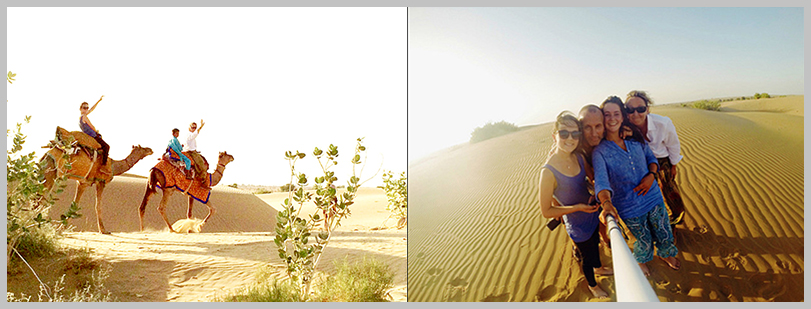
The McGuinness family took an overnight camel trek in Rajasthan, India, which one of the main highlights of their trip.
5. What was your greatest struggle?
The biggest negatives travelling as a family were also at times the biggest positives. I suppose that’s the big myth – that it’s all a big happy family all the way, and no one argues.
We had a really tight budget – always in family rooms or camping apart from a few places in Bolivia because it was so much cheaper. We had real problems with teenage moods – hellish at times. There was nowhere for anyone to go. You can’t just say to go upstairs and have some time out, go see a friend, or go for a walk because it was often too dangerous to let them walk alone. We were absolutely stuck together and that really did create problems at times.
Activities like the walking treks and climbing were the best because we all had some space. We all needed it at times. Conversely, it was also great at times to be altogether – music in the car, hiking in the most amazing places, travelling in big cities, meals together all the time, campfires and camp cooking. We have learned to live with disagreements better, I think, and we all know each other really well! Not sure if that’s good or bad!
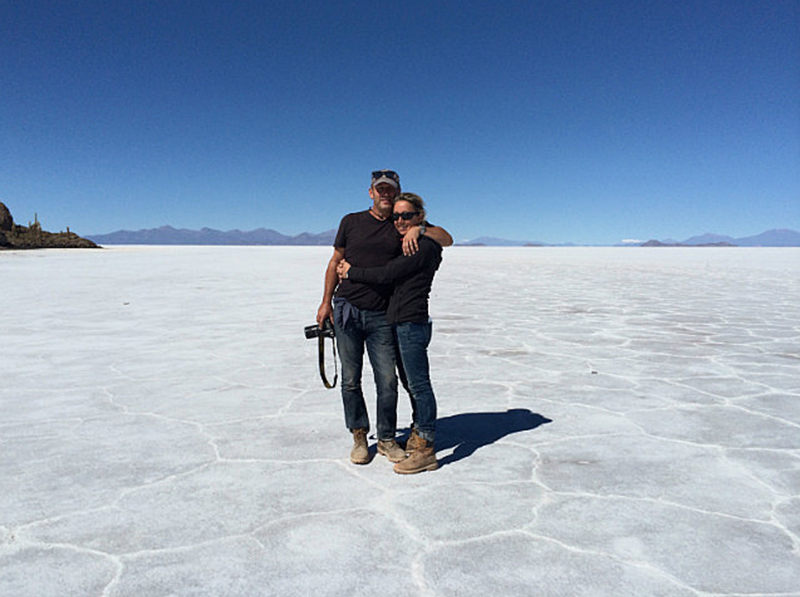
Rob and Cath McGuinness at Salar de Uyuni. They spent almost five weeks in Bolivia traveling with their two daughters.
6. What was your budget for the trip?
It’s really hard doing it on a budget as well, but we got better at it and in the main stayed within our budget of around £200 for everything per day. Easy in India, difficult in Australia (camper van hire was £80 per day before petrol, campsite fees and then food) or the U.S.
7. Can you share some advice for families wanting to do the same?
Be prepared for things not to be perfect, for things to go wrong and arguments. It is really stressful travelling as a group. You can’t just turn up somewhere without having a room booked or change plans at the last minute, and we struggled with our budget to find suitable places sometimes for the girls that felt safe. The things you think are going to be the best aren’t always, and other bits will surprise and delight when you least expect it. It wasn’t a holiday – a lot of it was really hard work. Rob and I were often tired holding things together, but the good bits outweigh the bad overall, and it was a real experience. I look back at the blog and photos and can’t believe all the things we did. I’m glad we went.
Since returning home, I’ve been really ill – out of the blue. I am recovering now, but I wouldn’t be able to plan the trip we’ve done now and so that makes it all the better that we went when we did. You never know what’s round the corner, and my advice to anyone thinking about a trip like this is that if you can do it, then get on and do it.
There’ll never be a perfect time.
It is hard, but the memories are worth it, and you may not have the chance again.
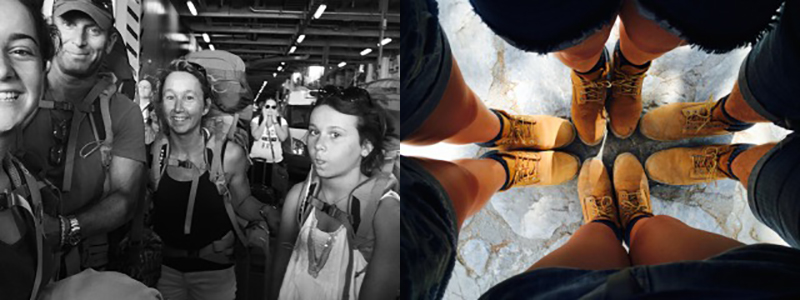
8. Name three things you always pack for a trip.
A good rucksack, unlocked iPhone (great camera, video and iPod) and a really good pair of boots that work as walking boots but also for walking round town in your jeans. (We splashed out on family Timberlands – they were great!)
9. What’s your next adventure?
Our next family adventure is building the extension on our cottage and finishing the girls’ education – we can’t live forever in a two-bedroom house. Although, after some of the places we stayed when travelling, it still feels big! I need fewer “things” after travelling, and we are all aware how lucky we are to live and work in the UK.
For more details about the McGuinness family trip around the world, check out their Travel Pod page: https://www.travelpod.com/travel-blog/mcgrtwtrip/1/tpod.html
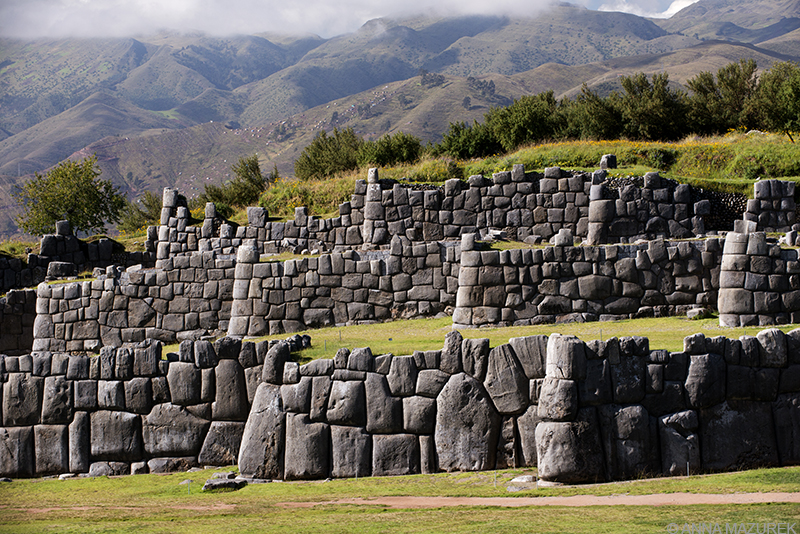
A Photo Guide to Peru’s Sacred Valley
Sometimes, food poisoning can be a good thing.
I mean that.
Thanks to a lovely case of dysentery or perhaps, it was some horrible Oregon Trail disease that I picked up in Bolivia, I arrived in Peru much earlier than planned. After I regained my appetite, I spent almost two weeks photographing all the amazing sites and countless alpacas around Cuzco, the gateway city to Machu Picchu.

Sacsaywamàn is the most impressive set of Inca ruins in close proximity to Cuzco, Peru. It is accessible by bus or a hiking trail.
The majority of the people I met were simply rushing to get to Machu Picchu without taking the time to explore the Sacred Valley, which lies 15 kilometers north of Cuzco. If I hadn’t picked up that nasty stomach bug in Bolivia, I might have missed out on some spectacular Inca ruins, herds of fluffy alpacas and postcard-worthy towns myself!
The dry season in Peru runs from May until September, which makes NOW the perfect time to explore the Sacred Valley and acclimatize to the altitude before heading to Machu Picchu.
TIP: Before leaving Cuzco, purchase an official tourist ticket (boleto turístico), which offers access to 17 sites over a 10-day period including Cuzco museums and four of the Inca ruins below. Boleto turísticos ($40 USD) are required, and only partial tickets ($22) are available at each site. A student ticket is only $25 with ID. Full tickets can be purchased at the COSITUC office at 103 Avenida del Sol in central Cuzco. Here are the best things to do in Cuzco, Peru.
Five Day Trips Near Cuzco, Peru
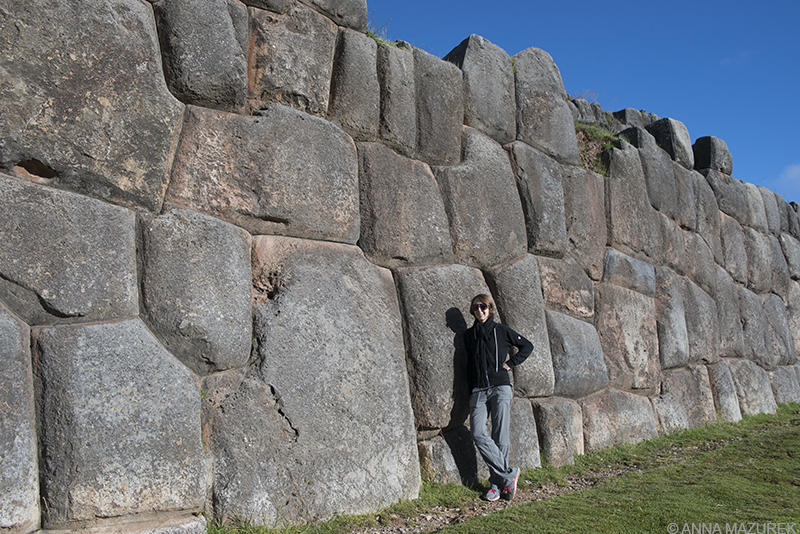
Only 20% of the original structure of Sacsaywamàn remains including some of the largest stones, which were too difficult to be moved. The most impressive feat of Inca ruins is the precision fit of each stone. I posed for a photo just for perspective!
1. Sacsaywamàn
Although Sacsaywamàn is technically not in the Sacred Valley, these impressive ruins on the edge of Cuzco include three tiers of zigzagged walls, which are significant from both a military and religious standpoint. The Inca’s envisioned Cuzco to be in the shape of a puma and the zigzag formations are said to be the puma’s teeth. In 1536, the Inca’s were tragically defeated here by the Spanish, who tore down many of the walls to build houses.
The best time to visit is sunrise when the ruins are empty and herds of alpacas wander through for perfect photo opportunities. (Of the five places listed, this has the heaviest amount of llama/alpaca traffic. FYI: I love alpacas!) The site is accessible by a two kilometer uphill trek from Plaza de Armas or by public bus. For safety reasons, avoid walking alone at sunrise. (I went at sunrise with two other people, and we had no issues.)
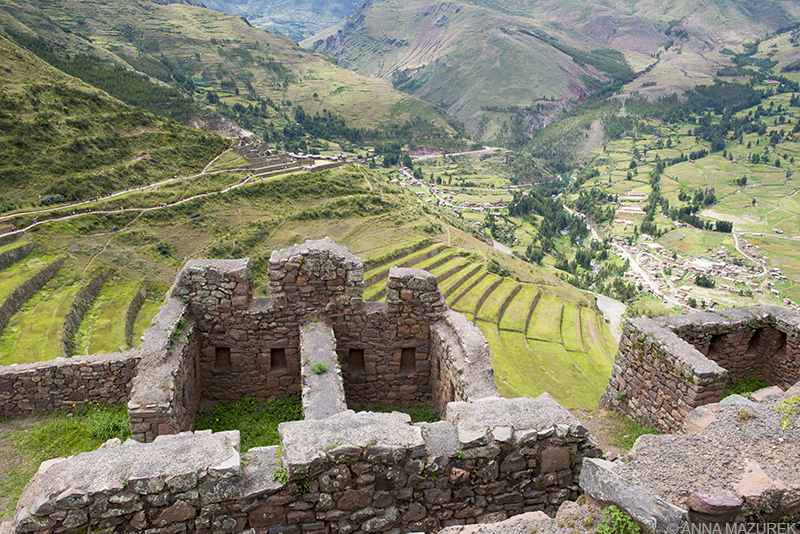
The colonial village of Pisac and its’ famous Inca ruins are 33 kilometers northeast of Cuzco and are accessible by public bus.
2. Pisac
The colonial village of Pisac is known for two things: a bustling market and the grand Inca fortress hovering above the city. While Tuesday, Thursday and Sunday are official market days, the market is so popular that it’s open to some extent every day. On market days, bus tours bring in hordes of people to the town and ruins. The main portion of hillside Inca citadel is a 30-minute walk from the entrance and is rarely visited. (Bus tours do not allow enough time to visit this section.) The best way to visit is to take a local bus from Cuzco to the town of Pisac. Then, walk the steep uphill four kilometer trail (two hours) to the ruins or take a taxi from town. Pack lots of snacks and water!
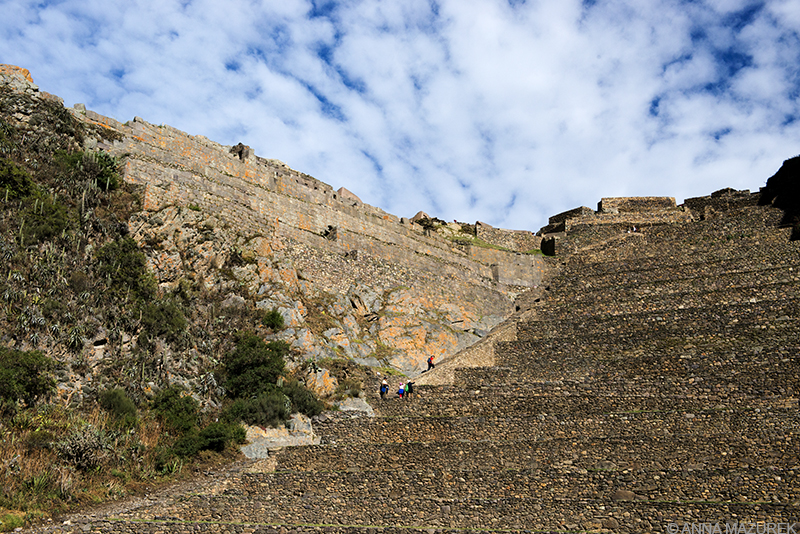
Ollantaytambo lies in a valley between two impressive Inca fortresses. It is also the main train stop en route to Agua Calientes.
3. Ollantaytambo
The picturesque town of Ollantaytambo is guarded by an impressive Inca fortress and temple lined with terraces linked by steep, lung-busting staircases. The city is a main transport hub between Cuzco and Machu Picchu and is very peaceful once the afternoon crowds depart. The quaint Inca village is filled with narrow cobblestone streets paralleled by irrigation channels. It has been inhabited consistently since the 13th century. Spend a couple days hiking and exploring nearby ruins. I stayed at Casa de Wow—a cute place with an excellent view of the ruins!
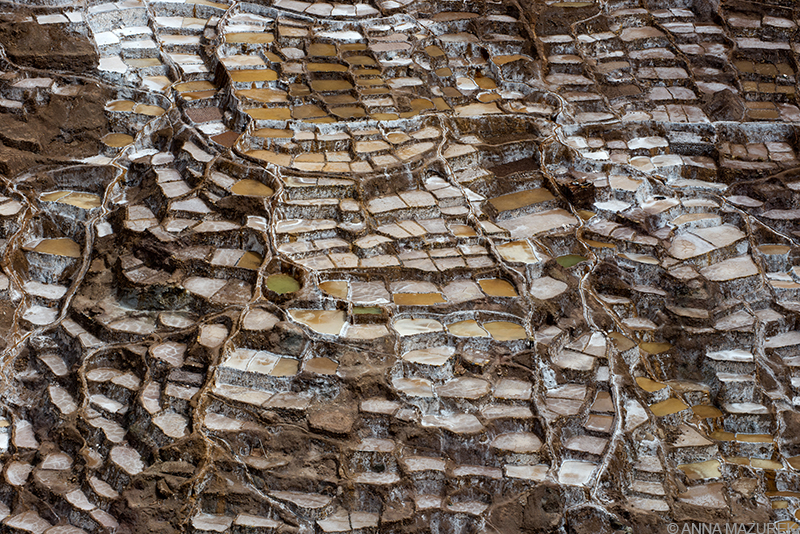
Visitors are allowed to walk on footpaths between the salt pools at Salinas, which have been in use since Inca times.
4. Salinas
Salinas is one of the most spectacular sites in the entire Sacred Valley—a mountain valley filled with hundreds of salt pools. The pools are fed from a hot spring of heavily salt-laden water, and the salt is harvested for cattle licks. Getting to Salinas on your own involves multiple forms of transport and wastes a good part of the day. A day tour from Cuzco ($10 USD) will save you time and hassle, and will allow you to also visit Moray (below). Tours will stop at an aerial viewpoint, then continue to the main entrance. Admission ($1.50 USD) is not included in the boleto turístico.
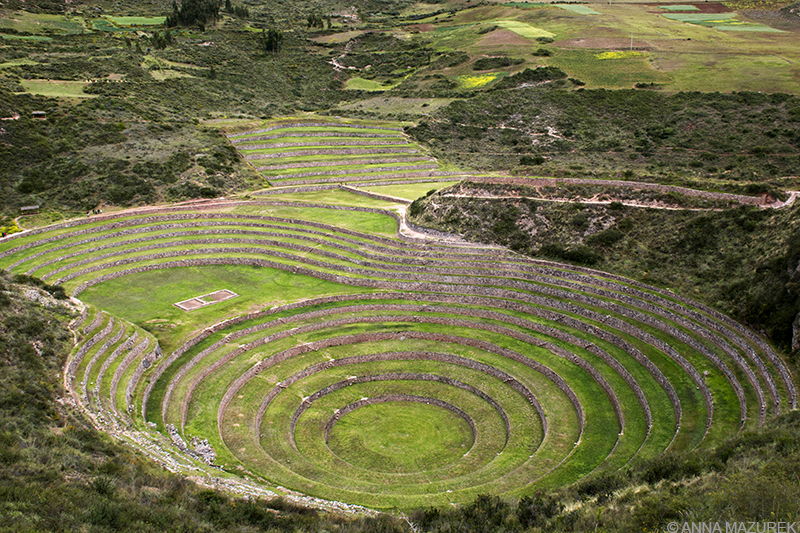
The terraces of Moray are not as crowded as other prime sites in the Sacred Valley like Pisac or Ollantaytambo.
5. Moray
The amphitheater-like terraces of Moray are stunning. Each of the three sets of terraces are carved into the earth like a tiered bowl. Each level has its own microclimate, which the Incas are theorized to have used to determine the optimal growing conditions for various species of crops. A day tour from Cuzco is the fastest, cheapest and easiest option to visit both Moray and Salinas above. Otherwise, a public bus can drop you off at the Moray turnoff, where taxis gather in high season.
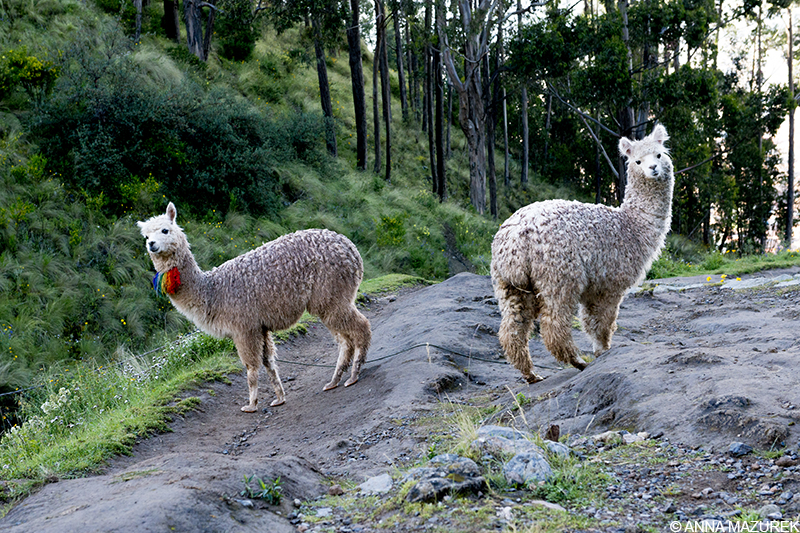
I met these cute little alpacas on my sunrise hike to Sacsaywamàn. (There was an alpaca or llama in 90% of my photos from Peru.)
WHEN TO GO TO CUZCO, Peru
June through August is peak season with the biggest crowds and festivals. Crowds thin in September and October. November through March are pretty wet. I went in late April, and the weather was fine! Temperatures are in the 60’s year-round, but nights are cold so stock up on llama sweaters and socks!
********************************************
COMING UP:
In the next Travel Tuesday Interview, I talk with Cath McGuinness about how her family of four spent almost a year traveling around the world! Sign up for more interviews from inspiring travelers on my home page!
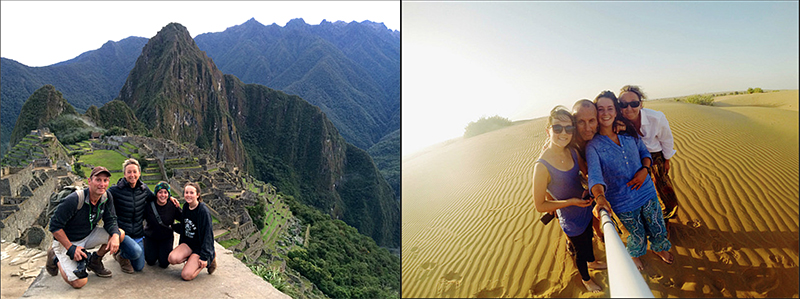
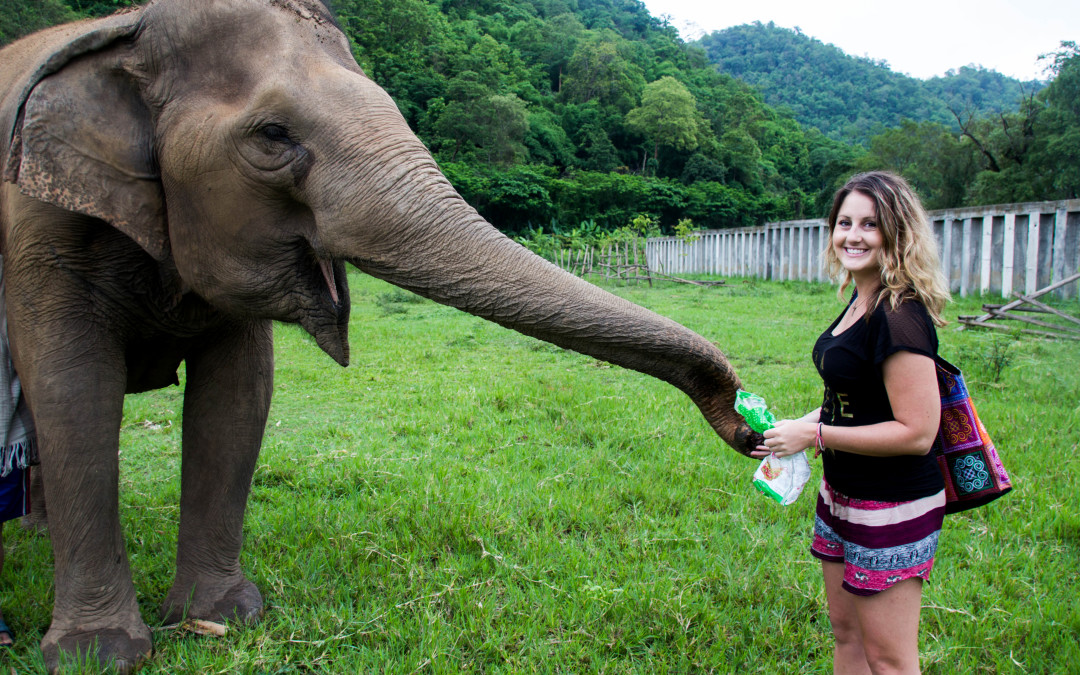
Funding a RTW Trip by Teaching English in Korea
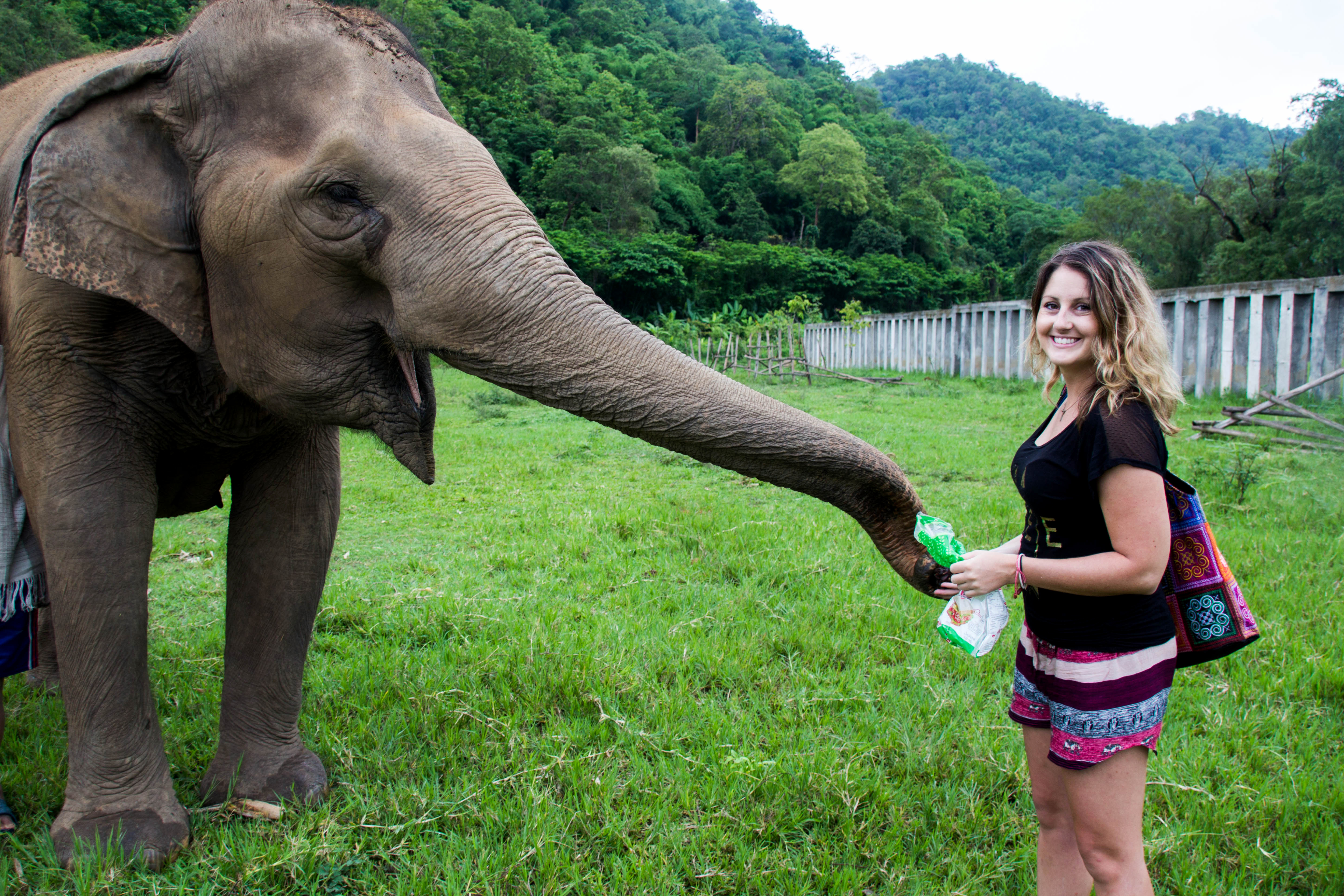
Kaleena Quarles funded her round-the-world trip by teaching English in Korea and spent time volunteering with elephants in Thailand. (All photos courtesy of Kaleena Quarles.)

One of the best ways to BOTH save money and TRAVEL is to teach English abroad. A few years ago, I met Kaleena Quarles through Couchsurfing.com when I moved to California. She let me sleep on her couch for a few days while I found my own apartment. She left to teach English in Korea a few months later, and I’ve followed her adventures relentlessly ever since. Kaleena talks about teaching in Korea and saving for her current round-the-world trip!
Name: Kaleena Quarles
Age: 29
Hometown: Ukiah, California
Country count: 31
Blog/Website: kaleenaskaleidoscope.com
1. How did you start traveling?
I was lucky enough to grow up in a family that took lots of vacations. We’d go to places like Hawaii and the Caribbean, and even spent a month in Europe. But, my first long-term backpacking experience was when I was 22, and I spent three months in South America. After that, travel became an addiction; it became my main passion and priority. I was constantly scheming ways to save money and squeeze in more trips.
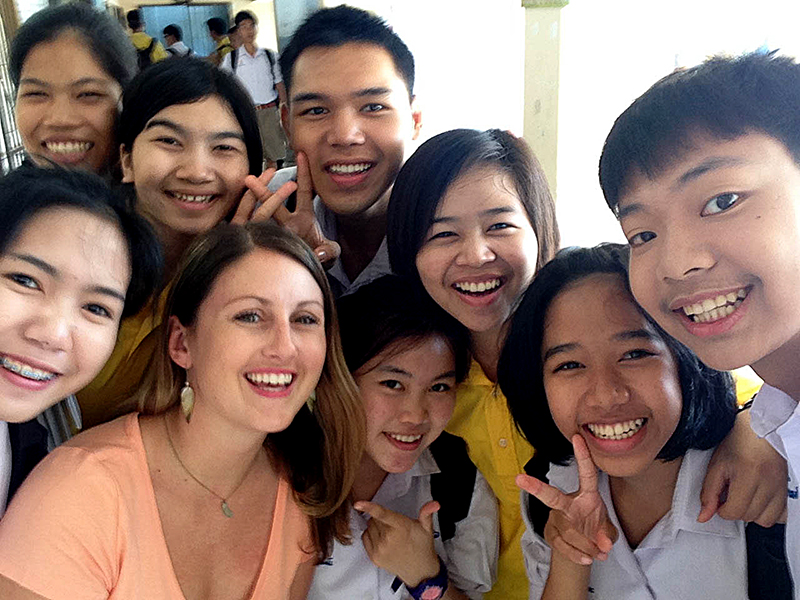
Kaleena taught English in both Thailand (above) and Korea to fund her RTW trip. (All photography by Kaleena Quarles)
2. Why did you decide to teach English in Korea? Tell us about your experience.
Teaching English in Korea killed two birds with one stone: I had always dreamed of living abroad, and I wanted to have a job that would allow me to save a lot of money in a short period of time. I was able to save $28,000 in Korea in two years while still taking plenty of vacations and eating ridiculously well. My experience in Korea was a mixed bag; I was dealt a really challenging job and had my differences with the culture, but there were certain things I loved (the food!), and I definitely have no regrets about the experience.
As for advice on teaching English in Korea, I’d say go for it! But, before accepting a position, do some research on the company. Ask if you can speak with another employee, ask about things like vacation and pay, etc. Some academies are great, but there are definitely dodgy ones out there that take advantage of foreign teachers so go with your gut before signing a contract. You can look on Dave’s ESL for jobs or try joining some Facebook groups and ask around, word-of-mouth is best.
3. Tell us about your most recent adventure.
When I left Korea last February, I embarked on a solo round-the-world trip. After a visit to the U.S., I traveled through Southeast Asia where I did everything from volunteering with elephants to training in Muay Thai to teaching English to getting my Advanced Scuba certification while diving on shipwrecks. Then, I headed to Australia and New Zealand where I cuddled koalas, worked on a farm, and [saw] the most breathtaking views ever. I’m currently living in New Zealand for a couple months until the travels continue. I’ll be hitting at least three more continents this year!
4. How do you fund your travels?
I saved like crazy during my two years in Korea to have a lump sum [$20,000 after pre-trip expenses] for my round-the-world trip. But, during my trip, I stretched the money by doing things like volunteering in exchange for accommodation, taking on short-term work contracts for teaching and farming, and staying with friends I’d met during my travels. I only paid for two nights’ accommodation during my three weeks in Australia thanks to having so many generous friends!
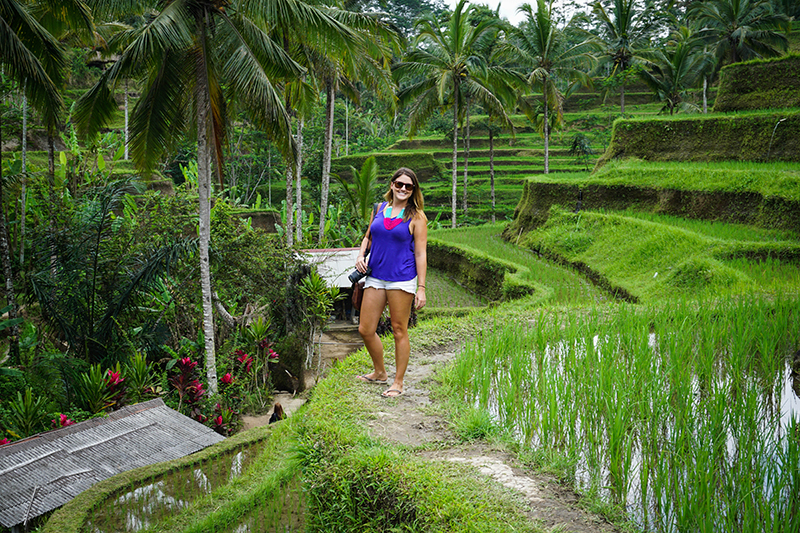
Kaleena stopped in Bali, Indonesia as part of her ongoing round-the-world trip. (Photo courtesy of Kaleena Quarles.)
5. Share one of your travel highlights.
The time I spent in Thailand was my favorite part of the trip last year. I had the opportunity to teach English for a month to some really awesome high school students and gain a better understanding of Thai culture. Then, I spent a week volunteering at an elephant rehabilitation park and two weeks training in Muay Thai in the northern jungles. It was all such a wonderful, unique experience!
6. What was your greatest struggle while traveling and how did you overcome it?
Well, that’s hard to choose… Was it the food poisoning that resembled an exorcism? The infuriating sand fly bites that made me look like a horror film monster? The jellyfish stings that swelled my eyes shut? The foot infection that I nearly lost my leg from? Getting stranded in a swamp during a monsoon? There are so many challenges when traveling, but the best way to deal with any of them is with a sense of humor. Sometimes the only way to cope is to laugh it off and know that it’ll make for a great story!
7. What advice would you have for aspiring travelers? Any tips for overcoming fear?
When I first started traveling, I met other female solo travelers and thought they were crazy. It just seemed so undoable to me. I didn’t jump straight into a solo round-the-world trip. I began with smaller trips with friends and worked my way up to bigger trips, eventually going on my own. So, I would suggest starting with what you’re comfortable with and easing into it. It’s all a learning process, but the most important thing is to just go for it!
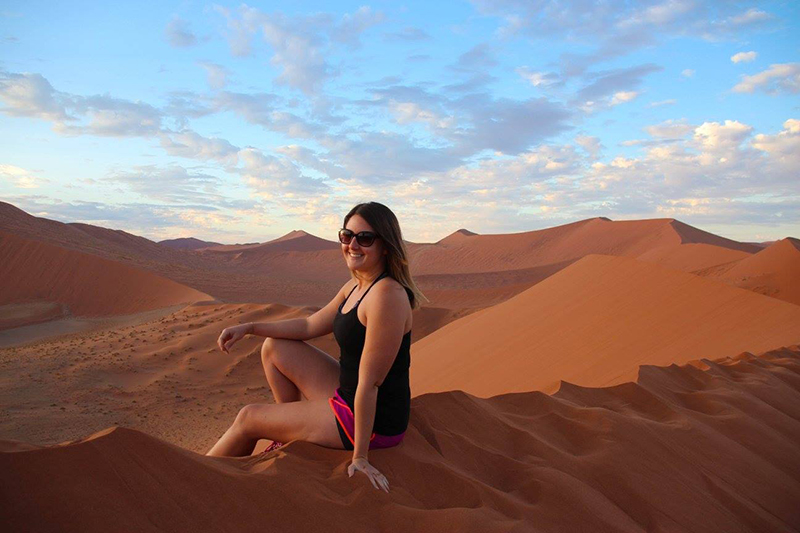
Kaleena did a safari in the Namibia Desert before heading to Greece to volunteer at a refugee camp. (Photo courtesy of Kaleena Quarles)
8. What is the biggest myth about traveling solo?
I think there are a lot of myths like that it’s unsafe, lonely and more difficult than traveling with someone, but I can say hands down that none of that is true! You should always take precautions when traveling, whether alone or not. Making friends while traveling alone is so easy because it makes you more approachable and people are often curious about you. And, when you travel alone, you don’t have to worry about compromising with anyone else on what to do—your itinerary is completely up to your own whim. Feel like sleeping in until noon and lying by the pool all day? Lounge away!
9. Name three things you always pack for a trip.
- Bikini: I’m a water baby and always hope there is some form of swimming to be done. Or at least a hot tub!
- Camera: Whether it’s my DSLR, GoPro or just my iPhone, I always make sure I have something to document my (ridiculous) adventures.
- Sunblock: Because I don’t want wrinkles to give away how old I’m actually getting.
10. What is your next adventure?
I’m heading to Africa! I have zero plans and a one-way ticket to Cape Town, South Africa so it should be the ultimate adventure! Follow Kaleena’s travels at kaleenaskaleidoscope.com!
********************************************
Want to teach English abroad?
For details about teaching English in Korea and other countries, check out my post about working abroad!
What is the REAL cost of long-term travel?
Check out the graphical breakdown of the cost of my seven-month Latin America trip HERE!
********************************************
COMING UP:
A Guide to Peru’s Sacred Valley
Summer is the peak travel season for Machu Picchu and Peru. Next week, I’ll be posting a detailed guide (including logistics) to five amazing places to visit in the nearby Sacred Valley. Give yourself a few extra days to enjoy the area and don’t rush to Machu Picchu!
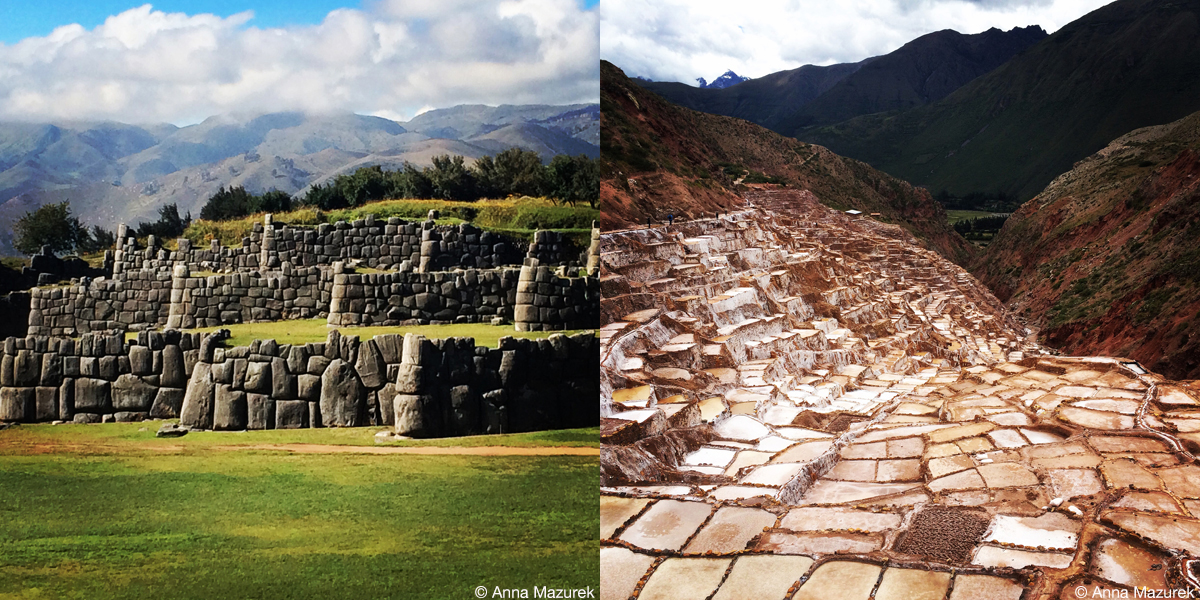
Peru’s Sacred Valley: Inca ruins of Sacsaywamán (left) and Salinas Salt Pools (right)
TRAVEL TUESDAY INTERVIEW:
How a Family of Four Spent a Year Traveling
In the next Travel Tuesday Interview, I talk with Cath McGuinness about how her family of four spent almost a year traveling around the world! Sign up below for more interviews from inspiring travelers!
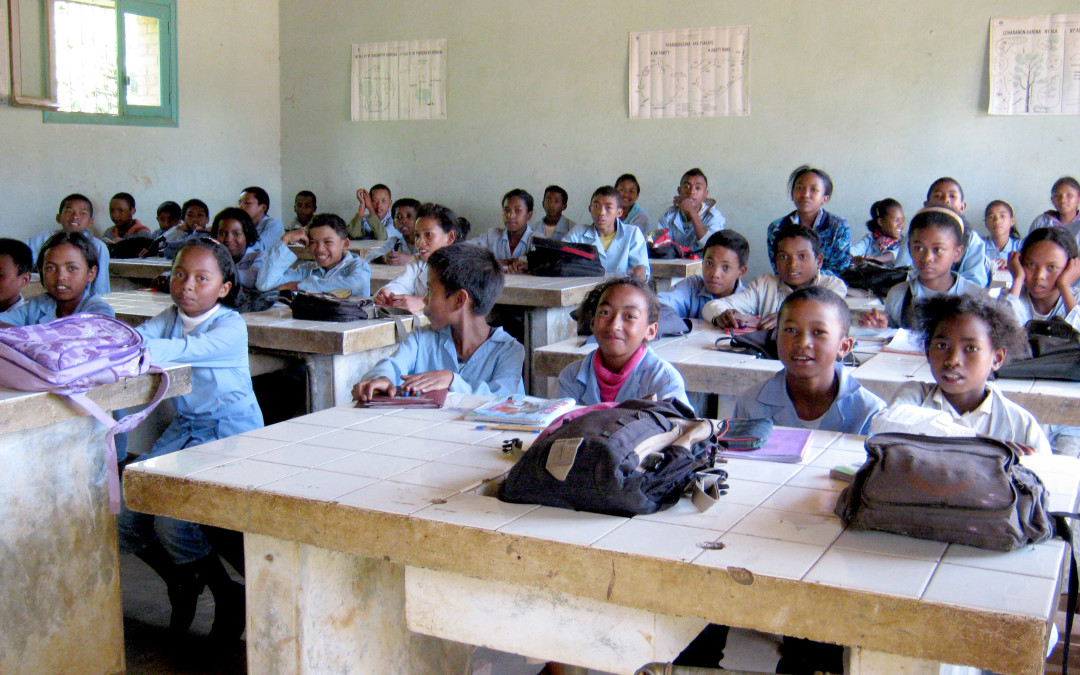
Peace Corps: Life in Madagascar

No matter where I travel, I always meet Peace Corps volunteers. A few years ago, I met Jessie Beck in Thailand when she was on vacation from her positon as a Peace Corps volunteer in Madagascar. Jessie gives us all the details and tips for life in the international service organization run by the U.S. government.
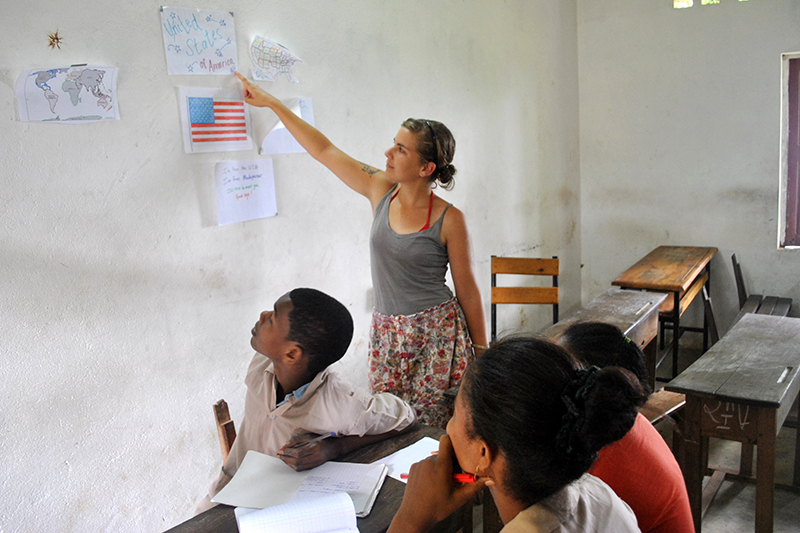
Jessie Beck spent 27 months teaching English in a small village called Antanifotsy in Madagascar. (Photography courtesy of Jessie Beck.)
Name: Jessie Beck
Age: 27
Hometown: Arlington, Virginia (Currently based in San Francisco)
Country count: 30+
Blog/Website: beatnomad.com
1. How did you start traveling?
My parents took me on my first international trip when I was one to visit Paris for France’s bicentennial. I just happen to share a birthday with France, and I guess they thought it’d be cute. Growing up, my dad would always joke that I’d have to go back for my 100th birthday.
2. Tell us about your experience in Madagascar in the Peace Corps.
I joined the Peace Corps in 2011 and was there for the standard 27 months of service as an Education volunteer. This meant that I taught English in a public middle school in a small village called Antanifotsy (which means place of the white land) outside of Antsirabe (place of lots of salt). I was the only volunteer in my village, but there were three [volunteers] that lived in Antsirabe so I ended up going there most weekends.
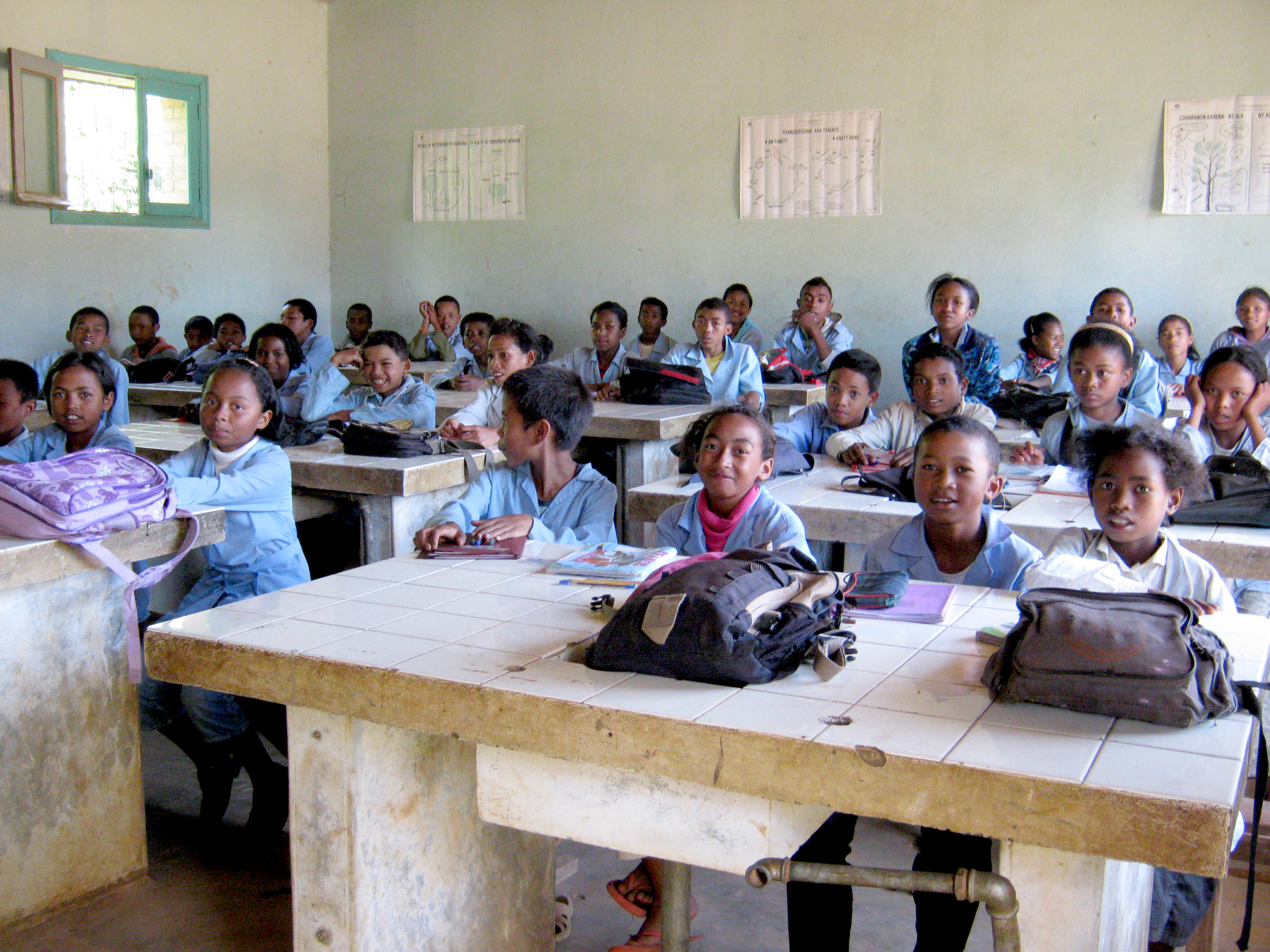
Peace Corps volunteers work in three sectors: education, agriculture and health. (Photography courtesy of Jessie Beck.)
3. What were the main roles of Peace Corps volunteers in Madagascar?
Peace Corps actually shifted their focus halfway through my service. When I started, they had four sectors: education, health, environment, and small business development. About halfway through, however, a new mandate from Washington stated that countries should have no more than three sectors, so environment and small business development sort of merged into one agriculture sector.
4. How much vacation time did you have in the Peace Corps? Where did you travel?
Peace Corps may not pay well [scroll down for pay details], but they’re pretty generous with vacation. We get two days per month of service, with the ability to use them in advance of actually serving the months for which we accrued vacation days. All in all, that means we had about 52 days throughout our service to play with.
One caveat: Technically, we’re “working” seven days a week, 365 days per year. So, vacation days had to be used to travel on weekends. Most volunteers got away with not taking vacation days for weekend trips in country (we could also travel to a nearby town for “banking purposes”), but if we went abroad, we had to use them. Basically, we were supposed to use vacation for every day that we weren’t “at site.”
Madagascar is both huge and isolated (I know it doesn’t look it on the map, but that’s probably because it’s next to Africa — also huge) so most of my trips were within the country. There’s so much to explore there—the natural parks like Andringitra, Isalo, and Ranomafana being the biggest highlights—and even though I traveled frequently, I still missed a few spots.
I also took two international trips: one to Thailand (where I met Anna!) and one to Reunion, a nearby French territory that’s one of the most amazing destinations I’ve ever been to. Seriously, it’s the perfect place for anyone who loves adventure travel, tropical fruit and a cafe where you can find a good espresso.
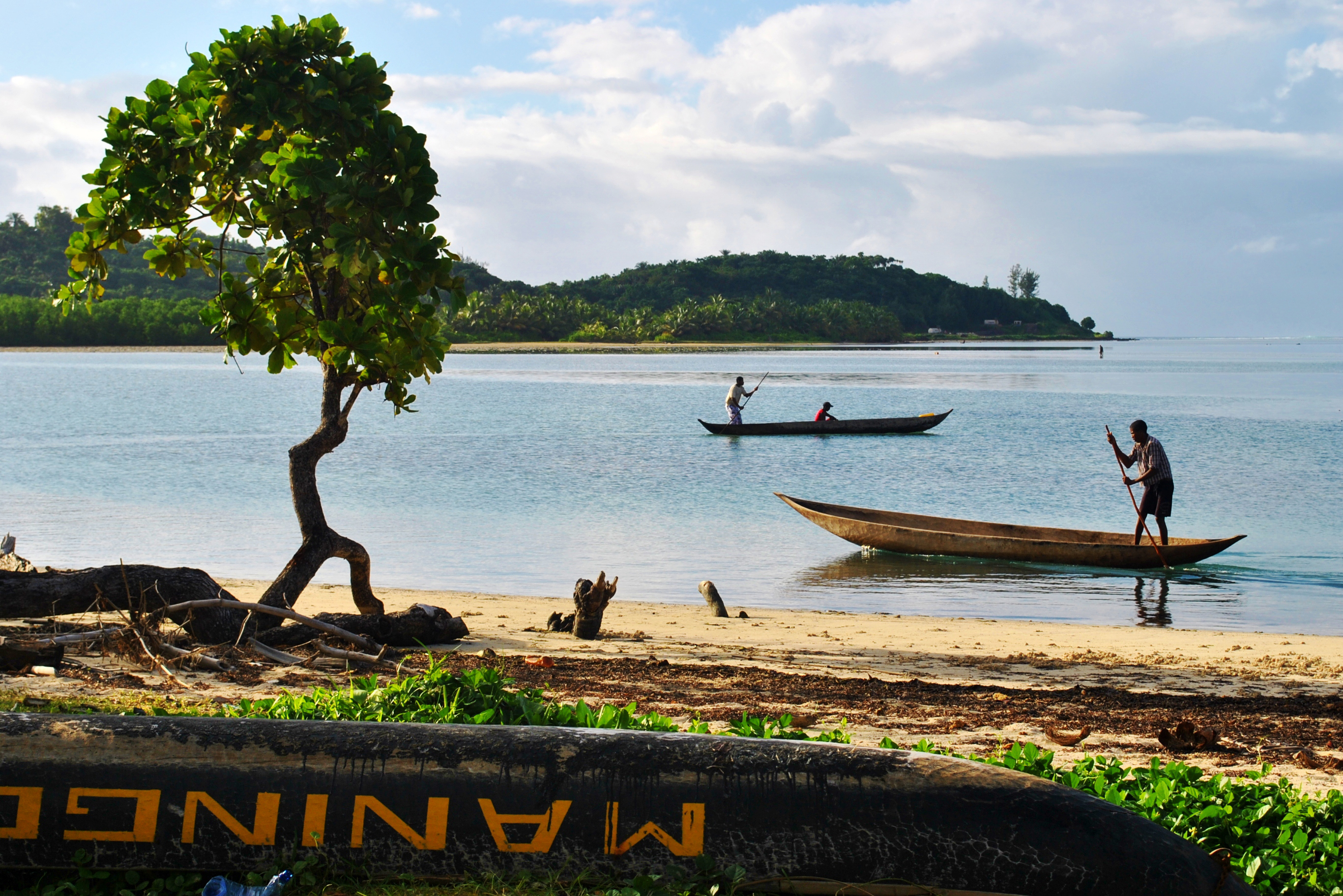
Ile Saint Marie was one of Jessie’s favorite spots in Madagascar. (All photographs courtesy of Jessie Beck)
5. Share one of your travel highlights.
About halfway through my service, a fellow PCV (Peace Corps Volunteer) and I were biking around Ile Saint Marie when a tropical downpour sent us running for cover. We ended up in this tiny three-room hotel and ordered coffee.
We were the only ones there, and the rain wouldn’t stop so after awhile my friend got to chatting with the owner, a middle-aged Malagasy woman, and I was talking with her daughter. Within an hour, the daughter and I were goofing off and watching cartoons while the mom and my friend were gossiping and pulling apart cassava leaves to make lunch.
I had several moments like these, and these fast and warm friendships really made me appreciate getting to serve in Madagascar. It’s this idea of “mandrosoa” or welcoming/inviting in that I always loved most about Malagasy culture—even if a lot of locals lamented about how it wasn’t as strong as the old days.
6. What was your greatest struggle and how did you overcome it?
Fear of missing out and not feeling like a real 20-something. While my friends at home were dating, getting careers, working out at the gym and going out to dinners/concerts/drinks, I was sitting in a dusty village cafe chatting about how it’s a great day to do laundry. Sometimes, the slowness could be tedious and made me feel older than I was.
I tried to cope by seeing other volunteers often, working out with videos, and eventually with distance cycling, but when I got home, I was definitely excited to do all of those little everyday things we take for granted like going on a date or taking a yoga class.
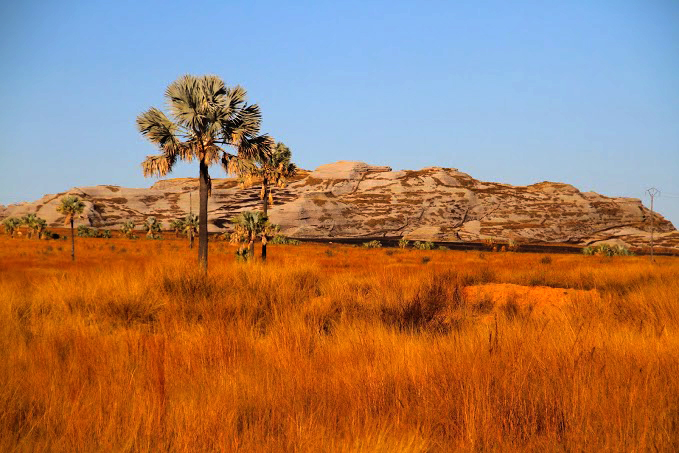
Isalo National Park is one of the many places Jessie visited during her time in Peace Corps.
7. What is the biggest benefit of joining the Peace Corps? What type of person should join?
There’s lots: you can grow, have adventures, learn a new language and be in a place long enough to truly understand it and bring that understanding back home with you. However, one of my biggest motivations for joining was the alumni network. PCVs are such a tight knit group of people and a wonderful network to be a part of!
However, if you’re not cut out for it, there’s the risk of doing more harm than good. Definitely join because you want to do Peace Corps, not because you don’t know what else to do with your life. Be committed to the organization, but simultaneously flexible and willing to adapt to whatever comes your way!
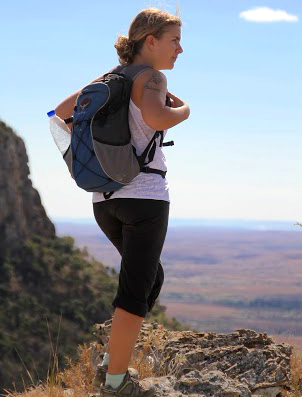
Jessie hiking in Isalo National Park, Madagascar.
8. What advice would you have for aspiring solo travelers? Any tips for overcoming fear?
I guess my biggest tip is:
The reality of traveling solo is never as scary as it seems and neither is making friends.
9. Name three things you always pack for a trip.
A collapsible water bottle (the Platypus), a bar of soap (so I can hand wash clothes if necessary), and one outfit/top I feel cute in.
10. What is your next adventure?
Hopefully, biking through Sweden with the boyfriend this summer! I can’t wait to experience a place that has 24 hours of sunshine!
********************************************
PEACE CORPS Details
HOW LONG: 27 Months
PAY & BENEFITS: During the time of service, volunteers receive a stipend for housing/food costs. Health insurance is provided. Other benefits include foreign language training and student loan deferment/cancelation. After completing their service, volunteers are paid $8,000 pre tax to use as they wish. Other benefits are listed here.
Check out my recent post about working abroad for more opportunities!
********************************************
COMING UP:
In the next Travel Tuesday Interview, I talk with Cath McGuinness about how her family of four spent almost a year traveling around the world! Sign up below for more interviews from inspiring travelers!
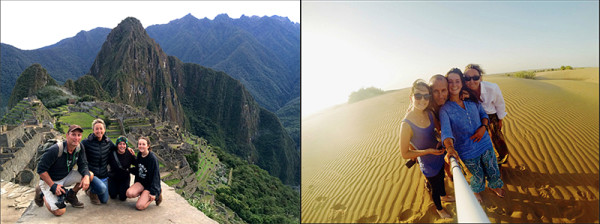
TRAVEL WITH ME:
Follow my summer travels on Instagram! Alfred the gnome and I are in the middle of a cross-country road trip!
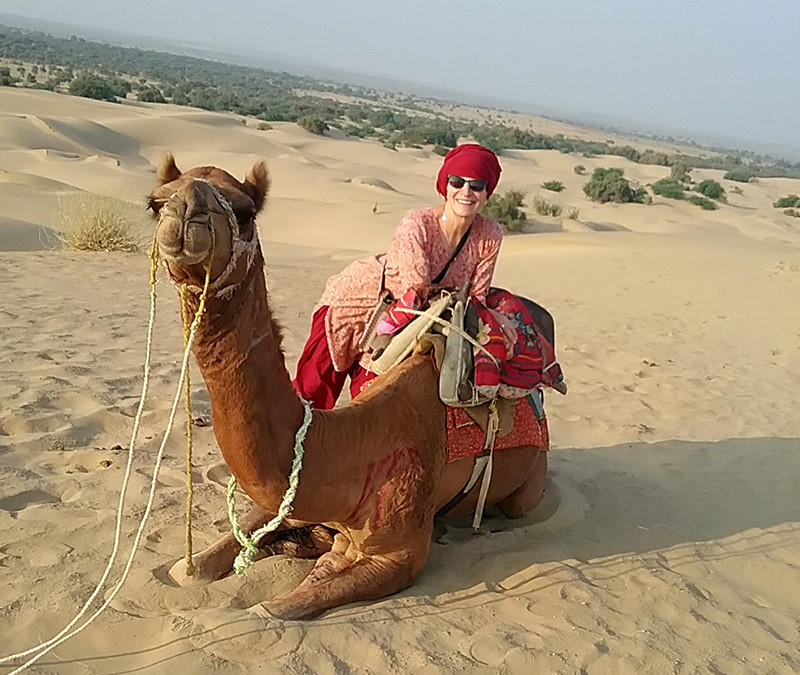
Interview with the (solo) Traveling Granny

Merrilee Davis is my hero. The self-proclaimed “Traveling Granny” started traveling solo in 2011 at age 64. I met her on a ferry from Panama to Cartagena, Colombia last year. Every time, I bumped into her in Cartagena she was practicing her Spanish with the locals, eating street food and always smiling. If the Traveling Granny can travel solo, why can’t you?
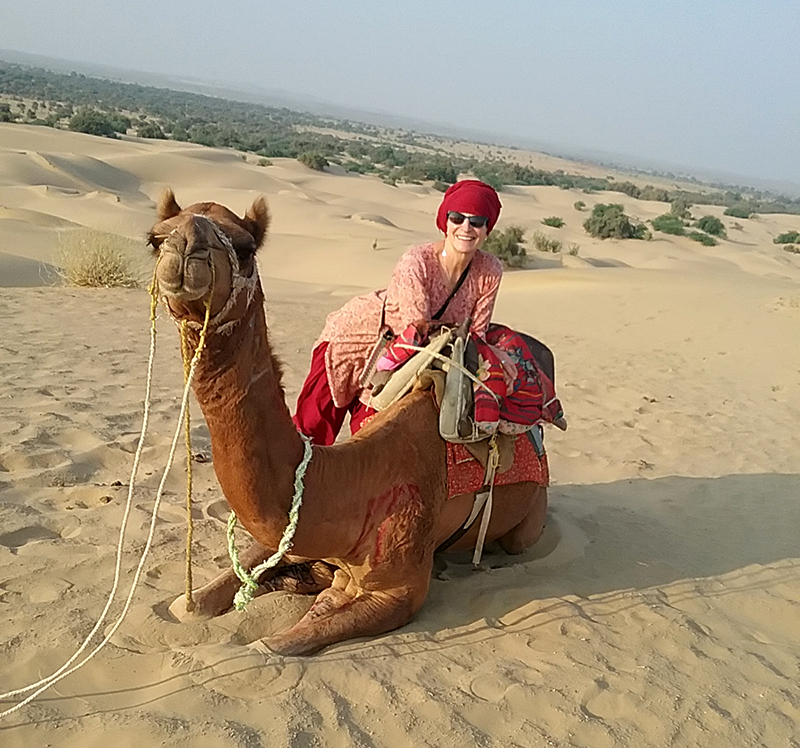
Merrilee Davis, 68, just returned from a five month trip in India and Sri Lanka, which included an overnight camel safari in Rajasthan, India. She has been traveling solo for four years. (All photographs courtesy of Merrilee Davis.)
Name: Merrilee Davis
Age: 68
Hometown: North Vancouver, British Columbia, Canada
Country count: 18 + including Mexico, Guatemala, Honduras, Nicaragua, Costa Rica, Panama, Colombia, Ecuador, Bolivia, Peru, Trinidad, Thailand, Laos, Vietnam, Cambodia, Sri Lanka, and India
1. How did you start traveling?
I use to travel with my husband on short trips away from our holiday home in Mexico. My first trip alone was to Guatemala to study Spanish for six weeks. I was very nervous to go on that first trip alone to what I thought would be a very undeveloped country. When I arrived, I loved my experience there! I stayed with a local family and studied five days a week for five hours each day in a school with a one-on-one teacher/student program. On Friday afternoons after class, I would hop the local chicken buses and head off solo to places in Guatemala to experience them for the weekend. It was then that I realized that it was not so scary [to travel solo], and I had the courage to just step out and get to know this country. I have been back three or four times since and having learned Spanish over the years has helped me in my travels in Central and South America. At my age, it is hard to learn a new language, but I again jump into just using it the best I can when I am traveling. The locals love that I am at least trying to speak Spanish. I think they also get lots of amusement out of the way I word things. Learning to laugh at oneself is part of the experience and to not to get hung up on being perfect.
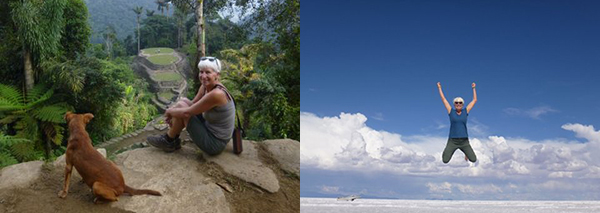
Left: Ciudad Perdida ruins, Colombia; Right: Salar de Uyuni (famous salt flats), Bolivia
2. How did you start traveling solo in your 60s?
After I left my marriage and spending every winter in our place in Mexico, I decided to explore more of the world. As I am thrifty, I chose places that were cheaper but fun. Spending mega bucks on a fancy hotel is not my idea of traveling nor is going with a tour group. I feel that I miss the interaction with the culture and locals if I get herded along with lots of other tourists. So, off I go backpacking with the young people but doing my own thing. They are either in awe of the traveling granny or totally ignore this older/gray-haired lady doing what they are doing. Actually, I do not choose hostels to stay in unless they have a private room. As I travel, I send emails to many of my friends and family with updates on my trip. I started to sign them “Traveling Granny” as I am now a grandmother seven times over. I so enjoy traveling solo as I have the time and flexibility to change plans at a whim without lots of discussion. Many times I have changed direction travelling, changed plans and being by myself, it is really easy to do this. No one to blame if I make a bad choice or decision. When I head off to a new country, I do very little research beforehand. I get off the plane with my travel book and tablet and start going. For me, it works to only make hotel reservations for those few nights when I arrive in a country if it is a long plane ride. After that, I find my accommodations as I go.
3. Tell us about your most recent adventure.
I just came back from India. All I can say is I cannot wait to go back. Such a huge country and so much to do and see.
4. How did you fund your travels?
I have enough money to travel the way I do as it is not expensive. Before I would rent out my house for the five months, but after a bad experience, I decided to leave my nephew there and travel without worries. So, I did not need to save money as usually it is cheaper to travel than to stay in North Vancouver for the winter season. I have pensions that I use to travel and that covers the costs. The most expensive is usually the airfare to my destination and home.
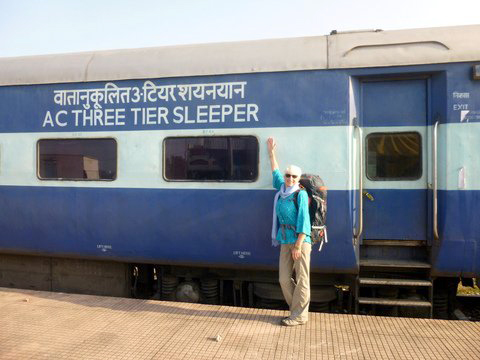
Merrilee traveled by train across India. She spent five months in India and Sri Lanka from November 2015 until March 2016.
5. Share one of your travel highlights.
[The following is an excerpt from Merrilee’s Traveling Granny emails from India]
The train pulls in and we all scramble, sometimes in the dark, to find our car number then seat or bench. On my last train ride, three guys were all on my lower seat, so I moved along to another compartment and joined a family and warmed the kids up to this grandma. The little gal, about four, was talking to me as though I understood everything. So, I just made up things to answer, and we had great fun. Lots of smiles and laughter.
Vendors going up and down the aisles with water, Chai, coffee, food, oranges, lassie (bit like a milkshake), and they must repeat the item billions of times in their lives in a shortened format or sing-song voice. The train food is very cheap, but one must be careful not to try it all. Who knows where it has been prepared.
6. What was your greatest struggle and how did you overcome it?
I can’t think of a great struggle. I do have difficulties seeing the abuse of the dogs in many countries. The mange, broken bones, lack of water and food for mostly the street dogs just pulls at my heart strings.
Maybe another struggle or difficulty is getting ready to leave my place for four to five months. Making sure I have thought of everything to pack and also taking care of what may need attention when I am away. I am learning that I am always a little anxious when I first head off to a new country, but when I land and start travelling that nervousness goes away. Stepping out of my comfort zone and leaping into the great unknown of a new country is always a mixture of emotions.
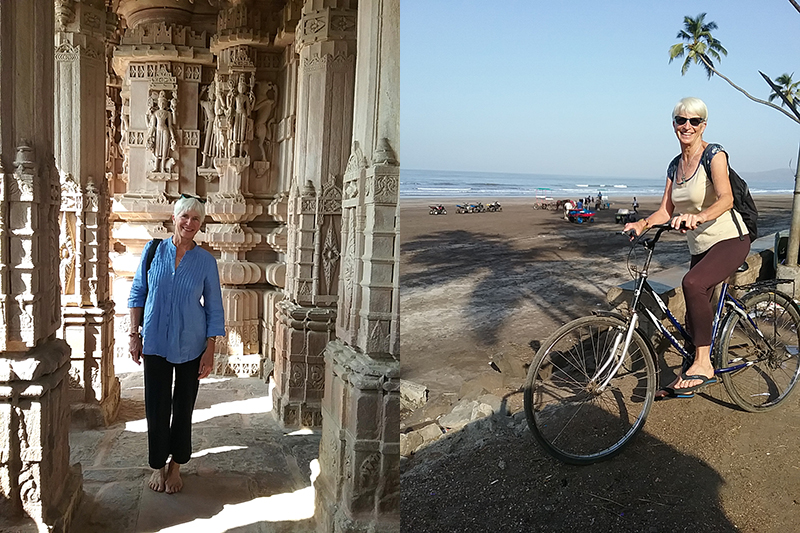
Left: Jain temple in Ranakpur, Rajasthan, India; Right: Murud, a small town on the beach south of Mumbai, India
7. What advice would you have for aspiring travelers over age 60? Any tips for overcoming fear?
I am still asking people what they are afraid of! So many of my friends say they are living vicariously through me as I travel. Why they do not get off the couch and do it themselves is a mystery. Sometimes, it is health or not enough money, but in most cases, they say they are afraid and that I am so brave. For me, it is a challenge, but I have life-changing experiences. I meet a few other solo women around my age when traveling but not many.
8. What is the biggest myth about traveling solo?
Not sure what this means, but sometimes people say that I will get mugged, raped, robbed. Actually at this age, the locals are very respectful of me and helpful. Having traveled for quite a few years now by myself, I have learned more travel smarts. I am very fit, energetic and active for my age so very little holds me back from experiencing it all out there. This last trip in India the men were always curious as to why I travel solo and they were intrigued with my contentedness without a man. I never felt threatened or afraid in India the whole time I was there.
9. Name three things you always pack for a trip.
- I always pack my double-bed silk liner. May not use it much, but if sheets are suspect or a non-existent top sheet or whenever it seems sketchy, I pull out my liner. Bought it in Vietnam, and it packs up very small in my backpack.
- Silicone ear plugs that mold beautifully into the ears. I take at least three pair of these, and they are a god-send at times. I do not use them all that much, but when needed on trains, buses, noisy hotels or guest houses, they are fabulous at blocking out the racket.
- Woven water-bottle holder that I bought in Guatemala. I carry a metal thermos that I can refill, and it fits perfectly in the holder. This frees up my hands as it is on a strap and also keeps the liquid cooler longer.
10. What is your next adventure?
I think back to India in the fall.
********************************************
COMING UP:
In the next Travel Tuesday Interview, I talk with Jesse Beck, a former Peace Corps volunteer in Madagascar about her experience. Sign up below for more interviews from inspiring travelers!
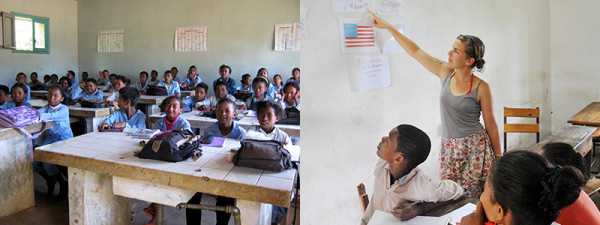
TRAVEL WITH ME:
Follow my summer travels on Instagram! Next week, Alfred the gnome and I head out on a road trip through the Southwestern U.S. via Antelope Canyon, Phoenix and White Sands National Park in New Mexico!
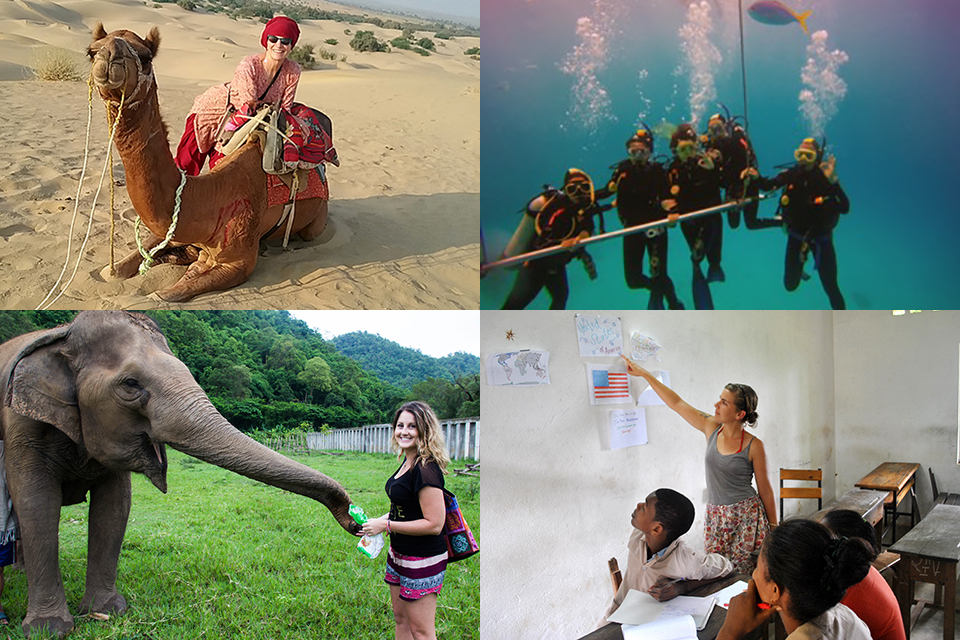
Travel Tuesday Interview Series


Clockwise from top left: Merrilee Davis, the solo Traveling Granny; the McGuinness family, a family of four who spent a year abroad; Jessie Beck, Peace Corps volunteer in Madagascar; Kaleena Quarrels, a former English teacher in Korea.
My favorite part about traveling is the people I meet along the way.
I have felt like an outcast my entire life. First, I was the girl with glasses AND braces. When I started traveling solo in college, I was even more of an outcast. Everyone thought I was crazy. When I left to study abroad in England, I started meeting people who were doing the exact same thing—traveling the world solo! They also refused to spend their entire lives waiting on other people to travel with them. There were times that I felt I connected more with a stranger in 15 minutes than people I had known my entire life. These strangers understood me in ways that only another traveler could. I didn’t have to explain why I was traveling, the sacrifices I made to be on the road or why sitting still made me stir crazy. We shared the same goals and struggle. Those people became some of my closest friends.
Last year, I met the Traveling Granny in Colombia—a 68-year-old woman from Vancouver who has been traveling solo for years. At a hostel in Surce, Bolivia, I met a British family of four who sold their house to travel for a year. From Peace Corps volunteers to English teachers in Korea to location-independent entrepreneurs to expert couchsurfers, I’ve met people who made travel and adventure their top priority. They have both challenged and inspired me. After all, courage is contagious.
As a journalist, I felt it was my duty to share their stories. After months of countless emails, I am launching my Travel Tuesday Interview Series next week! The series will feature interviews with inspiring travelers from across the world. Each shares their journey, struggles and travel/packing tips.
I am not the only person out there traveling the world. You are not the only person who wants to travel. Above all, I hope these stories give you that little nudge of courage to make travel a priority. You are not alone. 🙂
Feel free to share with anyone in need of a bit of travel inspiration. Follow along and sign up below to have the interviews delivered straight to your inbox.
COMING UP: The Travel Tuesday Interview Series starts with the solo Traveling Granny, 68-year-old Merrilee Davis, who has traveled solo across Latin America, Sri Lanka and India!
TRAVEL WITH ME: Follow my summer travels on Instagram! I’ll be in Iceland, Phoenix and everywhere in between!
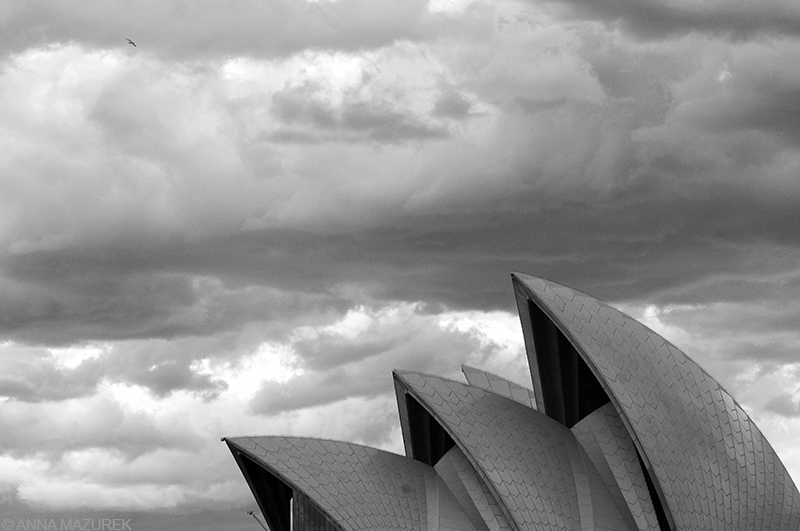
A Guide to Working Abroad

I miss seeing the Sydney Opera house everyday.
When I lived in Australia in 2008-9, I worked at a bar with a great view of the Sydney harbor. It was a great way to both fund my travels and meet people. (For more about my year in Australia, check out the story I wrote for AFAR magazine.)
My goal in life is to work as many random jobs as possible because I believe it builds character and great life skills. I have waited tables, worked retail folding clothes at the mall, bartended, photographed everything from farmers to the Foo Fighters (Dave Grohl is my hero!) for a variety of magazines, taught English in Thailand, ran photo trips in Asia and taught photography classes at American universities. After all, what pays the bills doesn’t define you. Your character is what defines you.
In my last post, I discussed the REAL cost of travel and broke down the cost of my 7-month Latin America trip. Now, I have complied a guide of ways to work abroad to help extend both your travels and savings. I have done many of these myself and have met people doing every option listed below.
Whether you are 18 or 68, there’s plenty of options for everyone.
Working Holiday Visas
I lived in Australia for almost a year on a Working Holiday Visa. These types of visas allow 18- to 30-year-olds to work while they travel. I worked a few random bar jobs and also photographed bands for Rolling Stone magazine. (Pretty random, I know.)
- Australia and New Zealand offer one-year visas for Americans and other many other nationalities aged 18-30, which allow you to work anywhere. Australia has a stipulation that you may not work for one employer for more than six months consecutively. Visa costs: $320 USD for Australia and $165 USD for New Zealand. Both visas include a stipulation that you must have at least $4,000-$5,000 in local currency in your bank account to enter the country, but they don’t always ask proof. (I was never asked in Australia.)
- For students or recent graduates, there are similar visa programs in South Korea ($45 USD fee), Canada ($200 USD), Singapore ($150 USD fee) and Ireland ($300 USD fee). You must do these programs within 12-months of graduating. Here’s a great guide for Working Holiday programs for Americans.
- If you have dual citizenship or you are NOT an American citizen, then consider looking into other Working Holiday Programs like Japan, Ireland, Italy and others. The programs in Australia and New Zealand are also open to a variety of different nationalities. There are far more opportunities available for non-U.S. citizens. For more info, this Linkedin article is a good resource.
- If you are interested in living in a country, a Working Holiday Visa is a good place to start. It can open doors to future careers and other visa options. Many of my friends got residency or a long-term work visa by starting with the Working Holiday program.
- Bunac is travel company that offers help with work visas for recent graduates (Ireland, intern in Britain, Canada), etc. They are great resource for information, but many of these programs you can apply for directly without their help.

I taught English to a kindergarten class at public school in Sisaket, Thailand. (Fridays were always pink shirt day.)
Teaching English
Teaching English is a great way to live abroad and fund your travels. I taught English in Thailand briefly and seriously considered similar opportunities in Korea and Japan. A Bachelor’s degree is required or preferred by many programs. A TEFL/TESOL certificate is not required for the programs listed below but can increase your salary. (FYI: I don’t have either certification. Private schools usually require it.) The highest paid programs are in Japan and Korea. Visas are almost always provided by employers.
The most established and highest paid programs provide the most training. Otherwise, be prepared to improvise. Be aware that many programs do not follow the traditional American/British school calendars for holidays (i.e. no Christmas break).
JAPAN
- The Jet Program is the most distinguished English teaching program in the country. Airfare is covered, and the salary is one of the highest in Japan. Housing and transport are subsidized. (A friend who did the program made $33,660 USD/year TAX FREE and only paid $130 USD in rent/month.) The application process is tedious and requires an interview at a Japanese consulate. A Bachelor’s degree is required. I applied once, got an interview but didn’t get the job. TIP: If you get an interview, be prepared to answer the following question: What would you say to a student who asked why the U.S. dropped the bomb on Hiroshima? (Yes, I was actually asked that question!)
- Other large teaching programs in Japan include AEON, Amity, Altia, Nova and ECC (These are all recommendations from friends who have taught in Japan.)
- For more info on Japan teaching programs and work visas, check out Tokyo Becky’s detailed guide!
KOREA
Most English teaching programs in Korea will cover airfare and accommodation. The application process can take a few months. An FBI background check is required a few months before leaving. (It’s not as scary as it sounds.) The best resource for jobs in Korea and other parts of the world is Dave’s ESL Café. Average salary is roughly $23,000 USD/year. Airfare, housing and visas are covered. Most start dates are in February or August. For more information, check out this guide to teaching in Korea.
THAILAND
I taught English briefly through AYC Thailand as a substitute teacher for a few weeks in a kindergarten class. Overall, it was a great experience. I’ve considered doing it again multiple times. I was paid 1,200 BHT/day ($34/USD) but would have made more if I had signed a contract with bonuses. Transport was covered from Bangkok to the teaching location. (I was eight hours away by train in a cool little town called Sisaket.) Since I was only substituting, my accommodation was covered so I lived on a few dollars a day. (I got free lunch at school.) Salaries are higher, and there are bonuses if you sign a semester contract. Public schools semesters run roughly from May to October and November to April.
Ajarn.com is a good resource for Thailand job postings. Many of my expat friends living and teaching in Thailand used this site.
OTHER LOCATIONS
- Greenheart Travel also offers programs in Thailand, Europe, Colombia and other parts of the world. I was accepted to teach English in Medellin, Colombia through their program. (I accepted a photography teaching position in the U.S. instead.) The position was stipend-based, included the visa but did not include transport costs. I recommend the company. The staff was really nice!
- Dave’s ESL Café also has a great job board for international opportunities.
Work Exchange
Work Exchange programs are a great way to volunteer your time in exchange for room and board. Many companies link hosts with volunteers. The time frame can range from days to months depending on the host. There is no age requirement, and it’s also possible to volunteer as a family with children. I’ve met many people during my travels who have used the programs below.
- Wwoof.net specializes with opportunities on organic farms across the world.
- WorkAway offers a variety of options including positons in schools, cafes, hostels and farms. Membership costs $29/USD per year. (I’ve stayed at many amazing hostels run by staff hired through Workaway and was offered a job at a few!)
- HelpX is an alternative to Workaway that provides positions at hostels, ranches and many other options. It costs 20 Euros for two-year membership. (One of my friends is in New Zealand now working on a farm through HelpX.)
Now, I’ve given you a huge amount of options so I fully expect you all to go out and start exploring the world! You no longer have any EXCUSES!
COMING UP: Travel Tuesday Interview Series! I am starting a long-term series of interviews with inspiring people I’ve met in my travels including a 68-year-old solo traveling granny, a British family (with two teenage kids) who sold their house to travel for a year, Peace Corp volunteers, English teachers in Korea, travel entrepreneurs and MORE!

